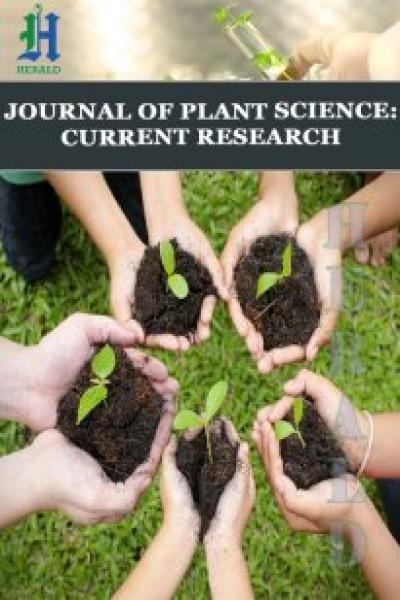
Performance of Organic and In-Organic Fertilizers for Growth and Yield of Tomato
*Corresponding Author(s):
Jazbia ShirinDepartment Of Botany, Hazara University, Mansehra 21300, KPK Province, Pakistan
Tel:8615555199120,
Email:jazbia.jazbia8@googlemail.com
Abstract
Present study evaluated two tomato varieties Sanam and Super Royal for different growth and yield parameters under eight treatments, including recommended dose (T0= 100-80-60 NPK kg/ha), organic fertilizers (T2= Humic acid @ 35kg/ha, T3= FYM @ 20 tons/ha, T4= Poultry manure @ 5tons/ha), In-organic fertilizers (T1=NP kg/ha 100-80-0) and combination of both fertilizers (T5= 50-40-30 (NPK) + Humic acid @17.5kg/ha, T6= 50-40-30 (NPK) +FYM @10tons/ha and T7= 25-20-15 (NPK) + Humic acid @17.5kg/ha +FYM @ 10 tons/ha +Poultry manure @ 2.5tons/ha) to select better variety and most suitable fertilizer treatment to improve the tomato production in agro climatic conditions of Mansehra. Variety Sanam performed better as compared to Super Royal for most of the studied parameters, such as sanam revealed highest plant height (75.1 cm), maximum average primary branches (10), maximum stem girth (10.4 mm), maximum number of leaves (337.3), more fresh weight (31.1 g) and dry weight of leaves (9.4 g), maximum root length (23.1 cm) and root weight (56.8 g), higher whole plant weight (296.1 g), maximum length of leaves (6.3 cm), higher total number of fruits/ plot (169.1) and total weight of fruits/ plant (7261.2 kg), maximum ratio between total soluble solids and titratible acidity (9.9). Fertilizer treatment T4 (Poultry manure @ 5tons/ha) showed maximum fruit diameter (52.9 mm), maximum fruit length (62.7 mm), higher total number of fruits/plot (180.2) and total weight of fruit/plot (10477 kg), higher amount of total soluble solids in tomato fruit (5.7 Brix0), higher ratio of total soluble solids and titratible acidity (14.1), higher amount of vitamin C (34.4 mg/100mL) and maximum stem girth (11.3 mm). Based on the findings of present study variety Sanam and fertilizer treatment T4 (Poultry manure @ 5tons/ha) are recommended for farming cultivation in Mansehra and other areas having similar climatic conditions. This will not only improve the economic return but also lower the market prices of tomato in the country because poultry manure is cheap and easily available everywhere.
Keywords
Branches; Nursery; Plant; Root; Tomato
Introduction
Solanum lycopersicon (L.) belongs to the family Solanaceae which contain many genera. The genus Lycopersicon, having plants of vast importance like potato (Solanum tuberosum), tobacco (Nicotina tabbacum), tomato (Solanum lycopersicon), jimson weed (Datura stramonium), tree tomato (Cyphomandra betacea or Solanum betaceum), husk or strawberry tomato (Physalis pruinosa), Eggplant (Solanum melongena), African eggplant (Solanum macrocarpon, Solanum aethiopicum), Cape gooseberry (Physalis peruviana), deadly nightshade (Atropa belladonna), and black nightshade (Solanum nigrum). Tomato (Lycopersicum esculentum) belongs to the family Solanaceae and is supposed to be the first domesticated in Mexico. The leaves and stem of tomato are compactly glandular, hairy and the flowers of tomato are 1-2 cm in size and are yellow in colour [1].
Varieties of tomatoes vary in the characters like yield, quality, shape, firmness and size, [2-4]. Based on the growth habit, tomatoes are often classified as indeterminate (develops in to the vine that never top off and continues generating fruit till destroyed by the frost) or determinate (bush bear fruit all at once and top off at a specific height). Commercial growers prefer determinate tomatoes, as they wish to harvest the whole field at once. While, home growers preferred indeterminate tomatoes and the small farmers who sell ripened fruits throughout the season in the market [5].
In United States of America (USA) and in several other parts of the world, tomato is the second major processed vegetable crop. In Karnataka alone, tomato is cultivated on an area of around 35,500 hectares accounting for the production of about 9.54 lakhs tons with the output of 26,896 tons per hectare [6].
As compared to the rest of the tomato producing countries per hector yield of the tomato is very low in Pakistan. This low per hector production is largely due to the fertilizer mishandling, poor selection of varieties, inadequate amount of nutrients, lack of information and paying no attention to the area as potential high yield area. To improve the tomato yield farmers generally depend upon the inorganic fertilizers because to boost up the yield of crop modern practises of agriculture encourage the usage of inorganic fertilizers, but it has toxic effects on the soil physic-chemistry. On the other side organic fertilizers like farmyard manure (FYM) enhances the properties of soil which effect the growth of plant [7]. As the rates of commercial fertilizers are high, the significance of Farm Yard Manures (FYM) as organic material is being acknowledged, as it comprises of rotted straw of plants, faeces and urine. It enriches the physical properties of soil such as holding capacity of water, erosion stability and gaseous exchange [8]. Farmyard manure (FYM) not only improves the physical, biological and chemical properties of soil but also supplies lots of micro and macro nutrients to the soil. Conventional farm yard manure (FYM) contains about 0.73% N, 0.71% K and 0.18% P [9]. Farmers used mostly Poultry manure because it is very low-cost and easily available, while in-organic fertilizers due to its high pricess are not within the reach of the poor farmers.
With over 100 million metric tons of the annual production and $1.6 billion market value, tomato (Solanum lycopersicum Mill.) ranks 1st and makes about 14% of the world’s vegetables production [10]. After the potato the second most essential vegetable crop is tomato [11]. Tomato is one of the most important vital vegetables which are grown worldwide for their edible fruits [12]. Tomato plant is a heat loving plant of the Solanaceae family. In Pakistan tomato is one of the most vital vegetable. It is a popular vegetable in home garden and a best source to achieve the energy necessities of the body [13]. It is the most important vegetable crop widely grown has exceptionally extraordinary nutritive importance and its versatile food uses [14-16]. Tomato is broadly grown in the tropical areas of the world; however its few cultivars may be grown under both temperate and tropical conditions [17].
In Pakistan and the other countries of the South Asia among the agricultural products tomato, onion and chillies are the most common vegetables. These vegetables like tomato; onions etc are cooked with the meat and other vegetables. They are also consumed as salad; therefore in Pakistan the demand of these vegetables is reasonably inelastic [18].
Tomato is the best source of minerals, vitamins, and antioxidants which are helpful in the cancer control, health diseases and also improves the general health [19]. Tomato is the most significant vegetable crop of the world which is widely used as salad and for the cooking purposes also. This vegetable crop is well known due to its nutritional significance, as it is the rich source of the nutrients K, Na, Fe and many antioxidants particularly salicylate and lycopene [20]. Tomatoes turn into one of the most important and popular vegetable which is broadly grown in the world. Agro climatic environments of Pakistan (ranging from the tropical to temperate region) tolerate the growing of 21 types of the fruits and 40 different kinds of the vegetables [21]. By and large, tomato is an essential part of the human diet and it occupies a key position in the modern agricultural systems. Tomatoes are consumed globally, fresh as a salad or may be hard-pressed into pastes or purees and then it is used for cooking soups or stews as well as for producing fruit drinks. However, it is important to note that, more than 80% of the tomato consumption goes to processed foodstuffs such as tomato juices, sauces and ketchup etc. The taste of tomato heavily relies on various organic acids and sugar components present in it [22]. Quality and nutritional value of tomatoes and its products are also influenced by the post-harvest management and storing conditions [23]. Latest studies about tomatoes showed its potential health benefits. For example lycopene, (a carotenoid without pro vitamin A activity) which is present in the red tomatoes and are widely known for many of its beneficial effects [24-26].
Besides being tasty, tomatoes are also a rich source of carotenoids, vitamin A and C along folate and flavonoids [26,27]. Tomatoes are often referred to as poor man’s orange [28]. Many of the carotenoids present in the tomato such as lycopene, flavonoids and beta carotene seem to guard humans from various types of cancers and different cardiovascular diseases [29,30]. Ascorbic acid (vitamin C), lycopene and potassium contents are the most important nutrients present in the tomato as they are beneficial to humans and [31] reported that, the intake of the tomato and its sub products such as juices, ketchup, paste etc were negatively linked with the prostate cancer and development of tumours in the digestive tract. Vitamin C is present in the tomatoes which play a vital role in the betterment of human health, it is found in the vegetables and fruits in the form of ascorbic acid. Major functions of ascorbic acid are the maintenance of blood vessels and skin and anticipation of the scurvy disease [32]. Wild species of tomato have been reported to contain double lycopene and Vitamin C (ascorbic acid) as the commercial cultivars of tomato. A major impact of globalization on the horticulture is that, it has increased the demands of worldwide improved quality, higher quantity, standards of fruit, vegetable and salad commodities. Around 13% of tomato dry matter are the organic acids (malic acid 4% and citric acid 9% and and 50% is sugar (fructose 25%, glucose 22%, sucrose 1%) etc. [33]. Among these, citric acid and fructose are most essential to sourness and sweetness than the others like malic acid and glucose. High concentrations of sugar together with relatively high concentration of acids are necessary for flavour, while high acids and low sugars makes a tart tomato, low acids and high sugars results in a bland taste and together low acids and low sugars produces a tasteless fruit [34].
Tomato (Solanum lycopersicum) is a nutritive and common vegetable all over the world [35]. In Pakistan, tomato is grown on 53.4 thousand hectares with an average yield of around 561.9 thousand tons of tomato while the tomato area in Punjab is 5.6 thousand hectare producing 72.5 thousand tons of tomato which is the highest yield as compared to the other parts of country [36]. Tomato crops are grownup in the two seasons in Khyber Pakhtunkhwa. In the plain areas summer crops are cultivated, while the winter crops are cultivated in some frost free zones like Dargai, Malakand Agency and Bara killey in Peshawar. In 2008-09 in Khyber Pakhtunkhwa over 16500 hectares area tomatoes were cultivated and entire production was 16800 tons [37].
Tomato is extensively grown in the green houses under controlled conditions of environment and as a vegetable in the home gardens. Beside its immense economic significance, it is also a best research material for the cellular, physiological, biochemical and molecular genetics investigations. It is very easy to grow, has a short life cycle than other vegetables and is amenable to the different horticultural manipulations like cutting and grafting etc. Various types of its explants may be cultured in vitro and plant regeneration is possible, allowing all sorts of developmental and transformation procedures with great ease [38]. The relatively few chromosomal number (2n=2x=24) and extensive genomic knowledge also make it as a model crop in the many experimental studies. The information and knowledge gathered from the studies over the last few decades, have contributed a lot to the remarkable improvements in productivity of our major crop plants [4,22,39-41].
High yields and enhanced fruit quality are the top priorities for the growers of tomato, since this can be achieved, only if the critical production aspects are taken into consideration, these factors include cultivar choice, proper irrigation, fertilizer use, disease preservation, climate and soil fertility etc. Moreover, the response of a vegetable crop like tomato to a particular nutrient status may vary with the cultivar and exogenous factors such as cultural practises, substrate and the conditions of environment. The provisions of nutrients to plants in quantities (that are best for their subsequent utilization) is the primary and an important aim in crop fertilizer programs. However, as both yield and quality are harmfully affected by the deviance from the optimum. It is very important to avoid the excess as well as deficiency of nutrients. In the recent years, an appreciable horticultural research has been keen to the subject of the tomato nutrition and standard levels of the supply of nutrients to the tomato.
Organic fertilizers increase the growth and development and advance the soil moisture and structure. Proper use of the organic fertilizers can be advantageous for the improvement of the yield and be more economic [42]. Soil fertility is a main over riding restraint that affects all the features of the crop production. In African region local farmers use insufficient nutrient inputs, unsuitable low quality and unproductive combinations of the fertilizers which prove to be very expensive at the end [43,44]. A consequence of this trend is a deeply unstable nutrient composition of soil that eventually leads to a decrease in the yield potential of crop [45]. When nutrients used in adequate quantity, increase fruit quality and quantity, fruit size, colour, and fruit taste of tomato [45,46].
Use of organic fertilizers could enhance the soil physical, chemical and biological properties. It also improves the rate of nutrients turn over within the soil-plant system but also facing many problems of dirt and bulkiness etc. [47]. In African soil, nutrient balances are frequently negative due to low level of fertilizer use and the depletion of the soil nutrient is a main reason for the decreasing or unproductivity of agricultural productivity [48].
The use of inorganic fertilizers with proper care and management can rise the yield of tomato crop [49]. By using In-Organic fertilizers, we can get highest growth of plant [50]. In the production of vegetable, organic fertilizers have verified to be effective in the combating nematodes [51].
The production of organically grown up vegetables crops has become gradually popular. In such a system, plant nutrients are provided at first by poultry manure, green manure, farm yard manure and compost and then by the regular uses of natural fertilizers [52]. Poultry manure is necessary for establishing and sustaining the optimum physical condition of soil for the better plant growth.
The organic fertilizers, largely processed wastes from the agro-food industry, it may readily release their nutrients into the soil, even though these by-products have been chiefly valued for many years as feed supplements [53]. Numerous studies have reported the useful effects of feather meal, blood meal and cheese on the field and quality of tomato, cabbage, corn, lettuce crops and wheat [54-56]. Farm yard manure (FYM) is the most important organic fertilizer in Pakistan as it is low-priced and easily available. It is estimated that, about 1.5 million tons of nutrients are obtainable from the farm yard manure [57]. Poultry manure is comparatively low-priced source of both micro nutrients (Fe, Cu, Mn, B) and macro nutrients (Ca, Mg, N, P, K, S) and these nutrients can rise soil nitrogen, carbon content, soil prosperity and enrich the soil microbiology, because poultry litter have high concentration of nutrients, thus by addition of suitable amount of poultry litter with proper care can overcome the crop nutrients necessity [58].
The industrial revolution followed by the green revolution triggered rise in yield per unit area in agricultural production, but they also caused increase in pesticides and synthetic fertilizers used in agriculture. In agriculture usage of concentrated inorganic fertilizer caused so many health difficulties and unrecoverable environmental pollution. To lessen and eliminate the adversative effects of synthetic fertilizers and pesticides on the human health and environment, new agricultural practises have been developed in the so-called ecological agriculture or sustainable agriculture and organic agriculture [59,60]. Organic fertilizers are taking the place of inorganic fertilizers in the ecological agriculture. The major sources of the organic fertilizers are the industrial wastes, composted livestock manures and plant residues. The organic fertilizers make available the nutritional requirements of plants and also help to subdue the plant pest’s populations. Additionally, organic fertilizers enhance the microbial activity in the soil, carbon-content of soil, cation and anion exchange capacity and organic matter. Organic fertilizers rise the yield and quality of the agricultural crops in ways alike to the in-organic fertilizers [45,61-67].
During current study, two varieties of tomato grown-up at National Tea and High Value Research Institute (NTHRI), Shinkiari Mansehra and the study was focussed on the evaluation of two varieties and to device a proper, balanced combination and scheme of fertilizers to increase the yield of tomato and to evaluate the impacts of combination of organic and in organic fertilizers on soil and also on the quality of the tomato with following objectives.
Objectives
- The research project was designed with the following main objectives.
- To investigate the comparative effects of organic and in-organic fertilizers on the growth and yield.
- To evaluate the impact of organic and inorganic fertilizers on quality of tomato.
To assess the impacts of organic and in-organic fertilizers on the soil.
Materials And Methods
Experimental site
Mansehra is a small city, located in between 34.20 to 34.33 N and 73.12 to 73.20 E. It is bounded in the north by Kohistan and the valleys of Diammer, in east by the capital of AJK, Muzzaffarabad, in south by beautiful Abbottabad and in west by the Kala Dhaka (Imperial gazetteer). The study area is at 3000 feet altitude, irrigated by the river Siran and its canals. It is located in the subtropical vegetation zone [68].
Large amount of the vegetables are grown-up in the Mansehra. Total area of the district Mansehra is 16,15,726 acres, but out of this only 2,39,829 acres (14.8%) is cultivated while the rest area is either uncultivable or unproductive. Still district Mansehra is a rich source of the different cereals like wheat, maize, rice and number of vegetables and fruits including potato, onion, cabbage etc and cash crops like tobacco and tea etc.
Tomato is produced in Mansehra but it is not amongst the major agricultural crops of the district due to the lack of information, awareness about the yield potential of the said area. The present investigation was carried out at the National Tea and High Value Crops Research Institute (NTHRI) Mansehra during March 2016 to August 2016 in order to find out the performance of organic and in-organic fertilizers for growth and yield of tomato. The experiment was laid out in randomised complete block design (RCBD) split plot with eight treatments and three replications for the each treatment and two varieties were used in this study, V1= Sanam and V2= Super Royal. Plot size was kept 5+10 sq. ft. with row to row distance of four feet and plant to plant distance of one feet.
Nursery preparation
Nursery was prepared at the National Tea and High Value Crops Research Institute (NTHRI) Mansehra. The seed beds were watered through sprinklers according to the necessity and protected regularly (Figure 1).
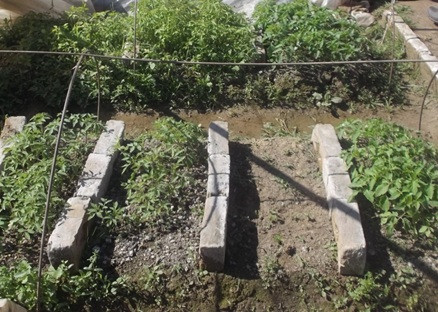 Figure 1: Nursery at NTHRI.
Figure 1: Nursery at NTHRI.
Land preparation
The land was prepared by ploughing, repetitive harrowing and plots were made for the experiment (Figure 2).
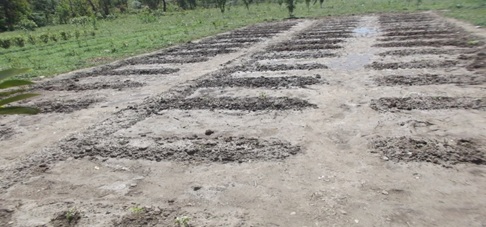 Figure 2: Prepared plots for plantation.
Figure 2: Prepared plots for plantation.
Soil sample collection
Twenty four soil samples were collected (at 0-20cm depth) for the determination of soil pH, electric conductivity, and organic matter concentration in the soil.
Applied of treatments
Eight treatments for each replication were made and preparing the treatments, applied them on beds and mix them with the soil.
Transplantation
Healthy and uniform sized seedlings were transferred to the prepared experimental plots and planted 240 plants (120=V1=Sanam and 120=V2=Super Royal) (Figure 3).
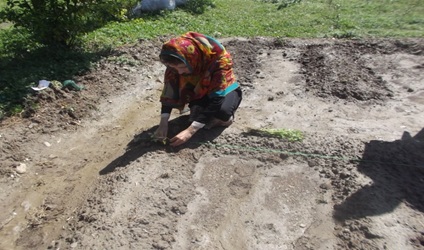 Figure 3: Transplantation of seedlings to the prepared plots.
Figure 3: Transplantation of seedlings to the prepared plots.
Experimental design
The experiment was laid out in RCBD split plot with the varieties in the main plot and the fertilizer treatments in sub plots, there were eight treatments for both varieties and three replications for every treatment (Table 1).
|
1. In-Organic Fertilizers |
|
|
2. T0 |
3. Recommended Dose: 100-80-60 (NPK kg/ha) |
|
4. T1 |
5. 100-80-0 (NP kg/ha) |
|
6. Organic Fertilizers |
|
|
7. T2 |
8. Humic acid @ 35kg/ha |
|
9. T3 |
10. FYM @ 20 tons/ha |
|
11. T4 |
12. Poultry manure @ 5tons/ha |
|
13. Combination of Organic and In-Organic Fertilizers |
|
|
14. T5 |
15. 50-40-30 (NPK) + Humic acid @17.5kg/ha |
|
16. T6 |
17. 50-40-30 (NPK) +FYM @10tons/ha |
|
18. T7 |
19. 25-20-15 (NPK) + Humic acid @17.5kg/ha +FYM @ 10 tons/ha +Poultry manure @ 2.5tons/ha |
Table 1: Treatments used in the study.
Weeding
During the growth period of the crop, hand weeding was carried our when required.
Irrigation
Depending on the soil moisture status and the climatic condition of the soil, each replication of the plot was irrigated.
Plant protection measures
Necessary plant protection measures were taken throughout the whole experimental period to control the pests and diseases. To control the cut worm from cutting the leaves and branches we sprayed cypermethrin (60ml cypermethrin mixed with 19 ml water in one pump). Curzate M-8 and Emamecctin Benzoate 1.9 EC were sprayed for the control of root rot and boll worm. Support was provided to the plants to stand firmly in the ground.
Parameters studied
To estimate the influence of fertilizers on the growth and yield of tomato following parameters were studied
Soil parameters
Pre harvest
Electric conductivity
Electric conductivity of the soil samples was determined with the help of conductivity meter.
pH
All the 24 samples collected from the plot, (at the depth of 0-20cm) were mixed, dried and grinded. After grinding, took 10 gram soil sample in 250mL conical flask and added 50ml distilled water and placed on shaker for 20 minutes. After shaking, allowed the suspension to stand for 30 minutes to settle the sediments. Then, for checking the functioning capacity of the pH meter, used 2 buffer solutions, one of which was having pH at the upper end and other at the lower end of the range of pH and after confirmation, measured the pH by immersing the combination electrode in to supernatant solution and recorded the pH in soil water suspension (1:1) ratio to the nearest one decimal point.
Organic matter
The importance of soil organic matter in providing the nutrients, contributing to cation exchange capacity, importing of soil structure etc is well recognised.
At pre harvest, composite sample of plots were used in the determination of organic matter. Determination of organic matter was based on the determination of its constant constituent’s i.e. carbon. Organic carbon was oxidized with excess of chromic acid and the unused chromic acid was determined by titration with the ferrous ammonium sulphate solution.
Reagents:-
- H2SO4
- H3PO4
- Potassium dichromate solution
- Dried 5g potassium dihydrogen phosphate in oven at 1050C for half an hour and then dried 5g Potassium Dihydrogen (4.3937) dissolved in 800mL distilled water and made volume up to 1000mL.
- Ferrous sulphate
- Dissolved 139g FeSo4.7H2O in 700ml of distilled water, mixed and then added 15ml of concentrated sulphuric acid. Placed in fumer for 30 minutes and diluted to 1 litre.
Diphenylamine indicator
Dissolved 0.5g diphenylamine in a mixture 100mL sulphuric acid and 20mL water and stored in a coloured bottle.
Procedure:
10g of soil was taken in a 500mL flask and added 10mL of NK2Cr2O7 by means of a pipette. Added 20mL of Conc.H2SO4 by means of a dispenser and shake the suspension gently and allowed to stand for about half an hour on asbestos sheet. Diluted the suspension by adding about 200mL of distilled water, also added 10mL of phosphoric acid and 1mL drops of diphenylamine indicator. A deep violet colour was produced, titrated against 0.5 ferrous sulphate solution till a brilliant green colour was produced and reading was noted, also prepared one blank solution, containing all reagents but no soil and treated in same way as the soil suspension.
Calculation:-
 Where: B= ml of ferrous sulphate solution used to titrate blank
Where: B= ml of ferrous sulphate solution used to titrate blank
S= ml of ferrous sulphate solution used to titrate the soil
N= Normality of the ferrous sulphate
0.003g= 1milli equivalent of C
As,
75% of the C is oxidiseable. 
As the soil organic matter has 58% carbon 
Post-harvest
After harvest, eight samples of soil were collected randomly from the treatments of three replications. Samples were dried, grinded and identified the same parameters as identified pre-harvest by the same procedure.
Electric conductivity
- pH
- Organic matter
- Vegetative parameters
Plant height (cm)
Plant height was measured from the randomly selected plants of each variety and replication with graduated scale from the ground level to the tip of the longest stem of the plant.
Leaf length (cm)
Length of ten leaves from each variety and replication was measured with graduated scale and then averaged and analysed.
Leaf width (cm)
Width of ten leaves from each variety and replication was measured with graduated scale, then averaged and analysed.
Stem girth (mm)
It was measured by the Vernier calliper 5cm above the ground level, averaged the data and analysed through statistics.
Root length (cm)
Root Length of the randomly selected plants of each variety per replication was measured with the graduated scale from hypocotyl to the tip of the plant root.
Root weight (g)
Root weight of randomly selected plants of each variety per replication was calculated with the help of electric balance, averaged and analysed.
Fresh weight of leaves (g)
Fresh weight of fifty leaves randomly from each variety and replication was calculated with electric balance, averaged and then analysed.
Dry Weight of leaves (g)
Dry weight of the fifty leaves was calculated from each variety and replication with the help of electric balance and then averaged and analysed the data.
Whole weight of plant (g)
Whole weight of the plant was calculated with electric balance, averaged and analysed by using statistics.
Number of leaves/plant
Total number of leaves of the randomly selected plants of the each variety per replication was counted when plants stopped producing buds and the recorded data was averaged and then analysed through statistics.
Number of primary branches
Total number of primary branches was counted, averaged and analysed by using statistics.
Number of secondary branches
Total number of secondary branches was counted, averaged and analysed by using statistics.
Physical parameters
Fruit length (mm)
Length of ten fruits from each variety and replication was calculated with help of graduated scale, then averaged the data and analysed.
Fruit diameter (mm)
Diameter of ten fruits from each variety and replication was calculated with help of Vernier Calliper, then averaged the data and analysed through statistics.
Number of fruits/plot
Total number of fruits of each variety and replication was counted, averaged and analysed.
Weight of fruits/plot (kg)
Weight of fruits of each variety and replication was calculated by using electric balance.
Biochemical parameters
Biochemical analyses were done to study the different constituents of the fruit i.e. total soluble solids (TSS), titratable acidity (TA), Vitamin C (Ascorbic acid). For the determination of all the biochemical components, fruit juice of all the replications were extracted and homogenized to study the biochemical attributes.
Total soluble solids (TSS)
For the determination of total soluble solids (TSS) digital Refractometer (Atago Japan PAL-1) was used. The instrument (Refractrometer) was every time standardised with the distilled water before use and after use. A single drop of tomato juice was placed on the prism of refractrometer and TSS (0 Brix) was noted direct from the digital refractrometer scale.
Titratable acidity (TA) (%)
Titratable acidity (TA) was determined, as identified by Hortwitz (1960). From each sample ten mL of tomato juice was taken in a 100 mL beaker and diluted (1:4) with the distilled water, titrated against N/10 NaOH solution after adding the 2-3 drops of the phenolphthalein (C20H14O4) as an indicator, till end point was attained. The results of the TA were expressed as % citric acid.
Calculations were by using the formula: 
Where, 0.0064 = correction factor
TSS: TA ratio
The ratio of titratable acidity (TA) and total soluble solids (TSS) was calculated by
dividing the total soluble solids with the corresponding values of titratible acidity.
TSS : TA ratio = TSS/TA
Vitamin C (mg 100 g-1)
Vitamin C (also known as ascorbic acid) is abundant in vegetables and fruits. It is a water soluble vitamin and powerful antioxidant.
It was determined by using the method, reported by Ruck (1969). Each sample of tomato juice of was filtered by the Whatman filter paper. Ten mL aliquot was placed in the round bottom flask, having the capacity of 100 mL and the volume was made up to mark (100 mL) by adding the 0.4% oxalic acid. After filtering, 5 mL aliquot was shifted in a beaker, titrated against dye (2, 6-dichlorophenol indophenol) with light pink colour as the end point, which persisted for ten-15 seconds. For the preparation of the dye 42 mg of the baking soda (NaHCO3), 52 mg of 2, 6-dichlorophenol indophenol were dissolved in the distilled water in volumetric flask. Up to 200 mL volume was made. Following formula was used for the determination of ascorbic acid,: 
Where,
D1 = mL of the dye used in the titration of aliquot
D = mL of dye used in the titration of 1 the mL standard A.A solution prepared
by adding 1 mL of 0.1% A.A + 1.5 mL the of 0.4% oxalic acid
A= mL of tomato juice used
V = volume of the aliquot made by the addition of 0.4% oxalic acid
B = mL of aliquot used for the titration
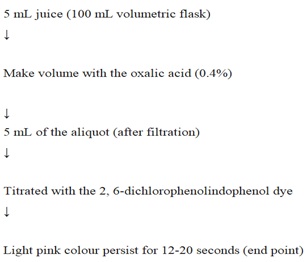
Flow chart for determination of the ascorbic acid content in the tomato juice.
Statistical analysis
Data collected on different parameters was statistically analysed using software Statistics 8.1. Using this software analysis of variance (ANOVA) and least significant difference (LSD) were applied.
Results
Plant height (cm)
Maximum plant height (81.2 cm) was noted in T0 in super royal followed by T4 (80.8 cm) at sanam and T5 (73.7 cm) at sanam while minimum plant height (67.3 cm) was recorded in T6 in super royal. Overall variety sanam showed better performance than the variety super royal (Table 2, Figure 4). Statistical analysis revealed that in variety super royal T0 (control) was significantly dissimilar from T2, T3, T5, T6 and T7 while T4 and T1 were non-significantly dissimilar from T0. In variety sanam T0 is significantly different from T1, T4 and T6 while all other treatments are non-significantly different from the control treatment (Figure 4).
|
Treatments |
Plant Height |
Primary Branches |
Secondary Branches |
Stem girth |
Number of leaves/plant |
Fresh weight of leaves |
Dry weight of leaves |
Root length |
|
Control (T0) |
81.2 A |
2.9 A |
11.8 A |
9.4 E |
291 C |
31.3 C |
8.2 CD |
20.9 CD |
|
NP (T1) |
73.4 ABC |
1.5 D |
9.6 B |
9.9 BCD |
375.6 A |
41 A |
7.2 D |
23 AB |
|
Humic acid (T2) |
72.3 C |
1.7 D |
8 E |
9.7 CDE |
274.4 C |
30 CD |
10 A |
21.6 BC |
|
FYM (T3) |
2.7 BC |
2 C |
8.4 DE |
10.1 BC |
298.9 BC |
24 E |
8 BC |
21 CD |
|
Poultry manure (T4) |
80.8 AB |
2.1 C |
8.9 C |
11.3 A |
375.5 A |
27 DE |
7.5 CD |
23.1 AB |
|
NPK + Humic acid (T5) |
73.7ABC |
2.2 C |
9 CD |
9.9 BCD |
293.7 C |
33.3 BC |
10 A |
19.6 D |
|
NPK+FYM (T6) |
67.3 C |
2.5 B |
10.4 E |
9.6 DE |
215.2 D |
35 B |
10.3 A |
21.3 BCD |
|
NPK + Humic acid +FYM +PM (T7) |
69.4 C |
2.8 AB |
10.9 B |
10.1 B |
325.9 B |
17.5 F |
7.2 D |
24.2 A
|
Table 2: Table showing means values for plant height, primary branches, secondary branches, stem girth, number of leaves/plant, fresh weight of leaves, dry weight of leaves and root length.
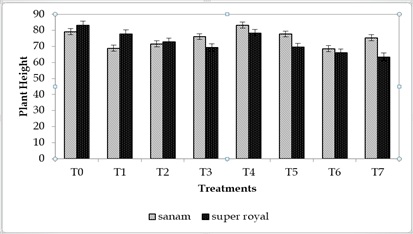 Figure 4: Plant height of two varieties (sanam and super royal) in different treatments (T0: Recommended Dose: 100-80-60 (NPK kg/ha), T1: 100-80-0 (NP kg/ha), T2: Humic acid @ 35kg/ha, T3: FYM @ 20 tons/ha, T4: Poultry manure @ 5tons/ha, T5: 50-40-30 (NPK) + Humic acid @17.5kg/ha, T6: 50-40-30 (NPK) +FYM @10tons/ha, T7: 25-20-15 (NPK) + Humic acid @17.5kg/ha +FYM @ 10 tons/ha +Poultry manure @ 2.5tons/ha).
Figure 4: Plant height of two varieties (sanam and super royal) in different treatments (T0: Recommended Dose: 100-80-60 (NPK kg/ha), T1: 100-80-0 (NP kg/ha), T2: Humic acid @ 35kg/ha, T3: FYM @ 20 tons/ha, T4: Poultry manure @ 5tons/ha, T5: 50-40-30 (NPK) + Humic acid @17.5kg/ha, T6: 50-40-30 (NPK) +FYM @10tons/ha, T7: 25-20-15 (NPK) + Humic acid @17.5kg/ha +FYM @ 10 tons/ha +Poultry manure @ 2.5tons/ha).
Primary branches
Maximum primary branches (2.9) were noted in super royal at T0 (control) followed by (2.8) in T7 in super royal and (2.5) at T6 in super royal while minimum primary branches (1.5) were noted in T2 in sanam. Overall super royal showed better performance than the super (Table 2, Figure 5). To showed significant difference from T2, T3 and T4 in both varieties sanam and super royal (Figure 5).
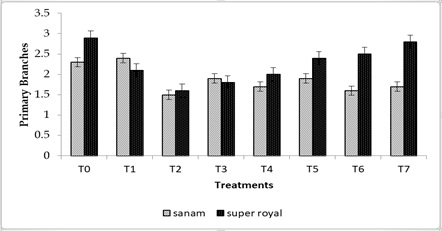 Figure 5: Primary branches of two varieties (sanam and super royal) in different treatments (T0: Recommended Dose: 100-80-60 (NPK kg/ha), T1: 100-80-0 (NP kg/ha), T2: Humic acid @ 35kg/ha, T3: FYM @ 20 tons/ha, T4: Poultry manure @ 5tons/ha, T5: 50-40-30 (NPK) + Humic acid @17.5kg/ha, T6: 50-40-30 (NPK) +FYM @10tons/ha, T7: 25-20-15 (NPK) + Humic acid @17.5kg/ha +FYM @ 10 tons/ha +Poultry manure @ 2.5tons/ha).
Figure 5: Primary branches of two varieties (sanam and super royal) in different treatments (T0: Recommended Dose: 100-80-60 (NPK kg/ha), T1: 100-80-0 (NP kg/ha), T2: Humic acid @ 35kg/ha, T3: FYM @ 20 tons/ha, T4: Poultry manure @ 5tons/ha, T5: 50-40-30 (NPK) + Humic acid @17.5kg/ha, T6: 50-40-30 (NPK) +FYM @10tons/ha, T7: 25-20-15 (NPK) + Humic acid @17.5kg/ha +FYM @ 10 tons/ha +Poultry manure @ 2.5tons/ha).
Secondary branches
Maximum secondary branches (11.8) were noted in T0 followed by T7 (10.9) and T6 (10.4) while minimum secondary branches (7.9) were noted in T2 (Table 2, Figure 6). T0 showed significant difference from T1, T2, T3 and T5 treatments in both varieties sanam and super royal (Figure 6).
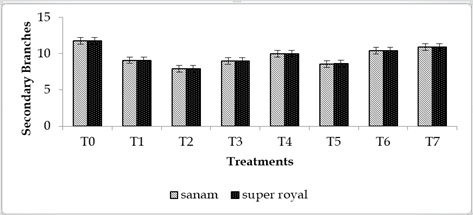 Figure 6: Secondary branches of two varieties (sanam and super royal) in different treatments (T0: Recommended Dose: 100-80-60 (NPK kg/ha), T1: 100-80-0 (NP kg/ha), T2: Humic acid @ 35kg/ha, T3: FYM @ 20 tons/ha, T4: Poultry manure @ 5tons/ha, T5: 50-40-30 (NPK) + Humic acid @17.5kg/ha, T6: 50-40-30 (NPK) +FYM @10tons/ha, T7: 25-20-15 (NPK) + Humic acid @17.5kg/ha +FYM @ 10 tons/ha +Poultry manure @ 2.5tons/ha).
Figure 6: Secondary branches of two varieties (sanam and super royal) in different treatments (T0: Recommended Dose: 100-80-60 (NPK kg/ha), T1: 100-80-0 (NP kg/ha), T2: Humic acid @ 35kg/ha, T3: FYM @ 20 tons/ha, T4: Poultry manure @ 5tons/ha, T5: 50-40-30 (NPK) + Humic acid @17.5kg/ha, T6: 50-40-30 (NPK) +FYM @10tons/ha, T7: 25-20-15 (NPK) + Humic acid @17.5kg/ha +FYM @ 10 tons/ha +Poultry manure @ 2.5tons/ha).
Stem Girth (mm)
Maximum stem girth (11.3 mm) was noted in T4 at sanam followed by (10.1 mm) in T7 at sanam and (10.1 mm) in T3 at sanam while minimum stem girth (9.4 mm) was noted in super royal at T0. Overall sanam showed better performance than super royal (Table 2, Figure 7). Statistical analysis showed that T0 is significantly dissimilar from all other treatments in variety super royal. In variety sanam T0 was significantly dissimilar from T4 while all other treatments were non-significantly different from the control treatment (Figure 7).
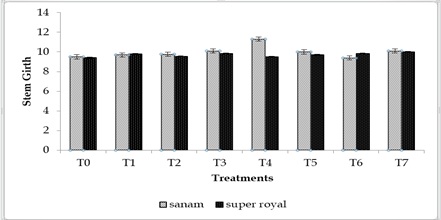 Figure 7: Stem girth of two varieties (sanam and super royal) in different treatments (T0: Recommended Dose: 100-80-60 (NPK kg/ha), T1: 100-80-0 (NP kg/ha), T2: Humic acid @ 35kg/ha, T3: FYM @ 20 tons/ha, T4: Poultry manure @ 5tons/ha, T5: 50-40-30 (NPK) + Humic acid @17.5kg/ha, T6: 50-40-30 (NPK) +FYM @10tons/ha, T7: 25-20-15 (NPK) + Humic acid @17.5kg/ha +FYM @ 10 tons/ha +Poultry manure @ 2.5tons/ha).
Figure 7: Stem girth of two varieties (sanam and super royal) in different treatments (T0: Recommended Dose: 100-80-60 (NPK kg/ha), T1: 100-80-0 (NP kg/ha), T2: Humic acid @ 35kg/ha, T3: FYM @ 20 tons/ha, T4: Poultry manure @ 5tons/ha, T5: 50-40-30 (NPK) + Humic acid @17.5kg/ha, T6: 50-40-30 (NPK) +FYM @10tons/ha, T7: 25-20-15 (NPK) + Humic acid @17.5kg/ha +FYM @ 10 tons/ha +Poultry manure @ 2.5tons/ha).
Number of leaves/plant
Maximum number of leaves/plant (375.6) was noted in super royal at T1 followed by (375.5) in T4 at sanam and (325.9) in T7 at sanam. Minimum number of leaves/plant (215.2) was noted in super royal in T6 at super royal. Overall sanam showed better performance than super royal (Table 2, Figure 8). For number of leaves/plant, T0 was significantly different T1, T4 and T6 while non-significantly different from all other treatments in variety super royal. In variety sanam, T0 was significantly dissimilar from T2, T6 and T7 and non-significantly from T1, T3, T4 and T5 (Figure 8).
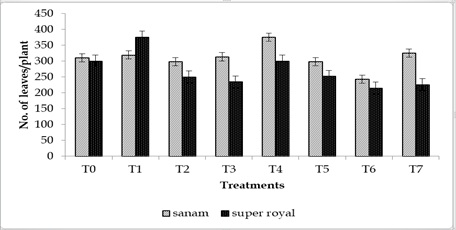 Figure 8: Number of leaves/plant of two varieties (sanam and super royal) in different treatments (T0: Recommended Dose: 100-80-60 (NPK kg/ha), T1: 100-80-0 (NP kg/ha), T2: Humic acid @ 35kg/ha, T3: FYM @ 20 tons/ha, T4: Poultry manure @ 5tons/ha, T5: 50-40-30 (NPK) + Humic acid @17.5kg/ha, T6: 50-40-30 (NPK) +FYM @10tons/ha, T7: 25-20-15 (NPK) + Humic acid @17.5kg/ha +FYM @ 10 tons/ha +Poultry manure @ 2.5tons/ha).
Figure 8: Number of leaves/plant of two varieties (sanam and super royal) in different treatments (T0: Recommended Dose: 100-80-60 (NPK kg/ha), T1: 100-80-0 (NP kg/ha), T2: Humic acid @ 35kg/ha, T3: FYM @ 20 tons/ha, T4: Poultry manure @ 5tons/ha, T5: 50-40-30 (NPK) + Humic acid @17.5kg/ha, T6: 50-40-30 (NPK) +FYM @10tons/ha, T7: 25-20-15 (NPK) + Humic acid @17.5kg/ha +FYM @ 10 tons/ha +Poultry manure @ 2.5tons/ha).
Fresh weight of leaves (g)
Maximum fresh weight of leaves (41 g) was noted in T1 at super royal followed by (35 g) in T6 at sanam and (33.3 g) in super royal at T5. Minimum fresh weight of leaves (17.5 g) was noted in super royal at T7. Overall sanam showed better performance than super royal (Table 2, Figure 9). In variety super royal, T0 was significantly dissimilar from T1, T3, T4 and T7 while non-significantly different from T2, T5 and T6. In variety sanam, T0 was significantly dissimilar from T1, T6 and T7 while non-significantly different from all other treatments (Figure 9).
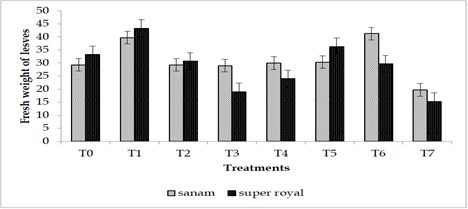 Figure 9: Fresh weight of leaves of two varieties (sanam and super royal) in different treatments (T0: Recommended Dose: 100-80-60 (NPK kg/ha), T1: 100-80-0 (NP kg/ha), T2: Humic acid @ 35kg/ha, T3: FYM @ 20 tons/ha, T4: Poultry manure @ 5tons/ha, T5: 50-40-30 (NPK) + Humic acid @17.5kg/ha, T6: 50-40-30 (NPK) +FYM @10tons/ha, T7: 25-20-15 (NPK) + Humic acid @17.5kg/ha +FYM @ 10 tons/ha +Poultry manure @ 2.5tons/ha).
Figure 9: Fresh weight of leaves of two varieties (sanam and super royal) in different treatments (T0: Recommended Dose: 100-80-60 (NPK kg/ha), T1: 100-80-0 (NP kg/ha), T2: Humic acid @ 35kg/ha, T3: FYM @ 20 tons/ha, T4: Poultry manure @ 5tons/ha, T5: 50-40-30 (NPK) + Humic acid @17.5kg/ha, T6: 50-40-30 (NPK) +FYM @10tons/ha, T7: 25-20-15 (NPK) + Humic acid @17.5kg/ha +FYM @ 10 tons/ha +Poultry manure @ 2.5tons/ha).
Dry weight of leaves (g)
Maximum dry weight of leaves (10.3 g) was noted in sanam at T6 followed by (10 g) at T5 in sanam while minimum dry weight of leaves (7.2 g) was noted in T1 at super royal. Sanam showed better performance than super royal (Table 2, Figure 10). In variety super royal, T0 was significantly dissimilar from T1, T3, T4 and T6 while non-significantly different to T2, T5 and T7. In variety sanam, T0 was non-significantly dissimilar from T2 while significantly different from all other treatments (Figure 10).
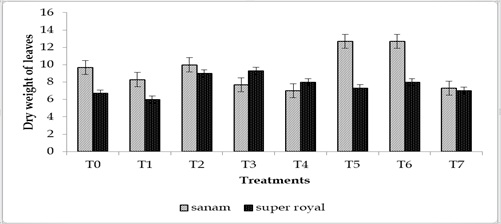 Figure 10: Dry weight of leaves of two varieties (sanam and super royal) in different treatments (T0: Recommended Dose: 100-80-60 (NPK kg/ha), T1: 100-80-0 (NP kg/ha), T2: Humic acid @ 35kg/ha, T3: FYM @ 20 tons/ha, T4: Poultry manure @ 5tons/ha, T5: 50-40-30 (NPK) + Humic acid @17.5kg/ha, T6: 50-40-30 (NPK) +FYM @10tons/ha, T7: 25-20-15 (NPK) + Humic acid @17.5kg/ha +FYM @ 10 tons/ha +Poultry manure @ 2.5tons/ha).
Figure 10: Dry weight of leaves of two varieties (sanam and super royal) in different treatments (T0: Recommended Dose: 100-80-60 (NPK kg/ha), T1: 100-80-0 (NP kg/ha), T2: Humic acid @ 35kg/ha, T3: FYM @ 20 tons/ha, T4: Poultry manure @ 5tons/ha, T5: 50-40-30 (NPK) + Humic acid @17.5kg/ha, T6: 50-40-30 (NPK) +FYM @10tons/ha, T7: 25-20-15 (NPK) + Humic acid @17.5kg/ha +FYM @ 10 tons/ha +Poultry manure @ 2.5tons/ha).
Root length (cm)
Maximum root length (24.2 cm) was noted in T7 at sanam followed by (23.1 cm) in sanam at T4 and (23 cm) in sanam at T1 while minimum root length (19.6 cm) was noted in T5 at super royal. Overall sanam showed better performance than super royal (Table 2, Figure 10). For root length, T0 was significantly dissimilar from T1, T4 and T7 while non-significantly different from T2, T3, T5 and T6 in variety sanam. In super royal, T0 was non –significantly dissimilar from T5 while significantly dissimilar from T1, T2, T3, T4, T6 and T7 (Figure 11).
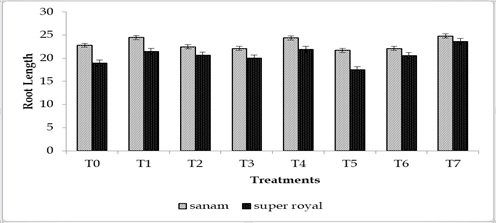 Figure 11: Root length of two varieties (sanam and super royal) in different treatments (T0: Recommended Dose: 100-80-60 (NPK kg/ha), T1: 100-80-0 (NP kg/ha), T2: Humic acid @ 35kg/ha, T3: FYM @ 20 tons/ha, T4: Poultry manure @ 5tons/ha, T5: 50-40-30 (NPK) + Humic acid @17.5kg/ha, T6: 50-40-30 (NPK) +FYM @10tons/ha, T7: 25-20-15 (NPK) + Humic acid @17.5kg/ha +FYM @ 10 tons/ha +Poultry manure @ 2.5tons/ha).
Figure 11: Root length of two varieties (sanam and super royal) in different treatments (T0: Recommended Dose: 100-80-60 (NPK kg/ha), T1: 100-80-0 (NP kg/ha), T2: Humic acid @ 35kg/ha, T3: FYM @ 20 tons/ha, T4: Poultry manure @ 5tons/ha, T5: 50-40-30 (NPK) + Humic acid @17.5kg/ha, T6: 50-40-30 (NPK) +FYM @10tons/ha, T7: 25-20-15 (NPK) + Humic acid @17.5kg/ha +FYM @ 10 tons/ha +Poultry manure @ 2.5tons/ha).
Root weight (g)
Maximum root weight (68.2 g) was noted in T5 at sanam followed by (61 g) in sanam at T1. Minimum root weight (49.3 g) was noted in T2 at sanam. Overall sanam showed better performance than super royal (Table 3, Figure 12). In variety super royal, T0 showed significant dissimilarity from T1, T2, T3, T4, T6 and T7 while non-significant dissimilarity from T5. In variety sanam, T0 showed significant difference from T2, T3, T5 and T6 while non-significant difference from T1, T4 and T7 (Figure 12).
|
Treatments |
Root weight |
Whole plant weight |
Length of leaves |
Width of leaves |
Fruit length |
Fruit diameter |
Total number of fruits/plot |
Total weight of fruit/plot |
|
Control (T0) |
52.2 CD |
433.6 A |
6.6 A |
3.8 A |
54.5 B |
40.6 C |
129.2 D |
6099 F |
|
NP (T1) |
68.2 A |
379.9 B |
6.4 AB |
3.9 A |
53.2 BC |
43.6 B |
153.3 C |
7256 D |
|
Humic acid (T2) |
49.3 D |
269.8 E |
6.5 A |
3.8 A |
51.3 C |
40.3 C |
121.5 E |
4867 G |
|
FYM (T3) |
57.2 BC |
269.8 E |
5.9 C |
3.5 C |
51.3 C |
40 C |
158.2 B |
6769 E |
|
Poultry manure (T4) |
52.8 CD |
300.7 C |
6.3 AB |
3.7 AB |
62.7 A |
49.4 A |
180.2 A |
10477 A |
|
NPK + Humic acid (T5) |
61 B |
286.3 D |
6.2 B |
3.8 A |
61.5 A |
48.4 A |
154.8 BC |
7842 C |
|
NPK+FYM (T6) |
52.2 CD |
166.2 G |
6.3 AB |
3.8 A |
53.7 BC |
41.4 BC |
85.8 F |
4503 H |
|
NPK + Humic acid +FYM +PM (T7) |
57.2 BC |
272.8 E |
5.7 C |
3.5 BC |
60 A |
48.9 A |
155.3 BC |
8989 B |
Table 3: Table showing mean values for root weight, whole plant weight, length of leaves, width of leaves, fruit length, fruit diameter, total number of fruits/plot and total weight of fruits/plot.
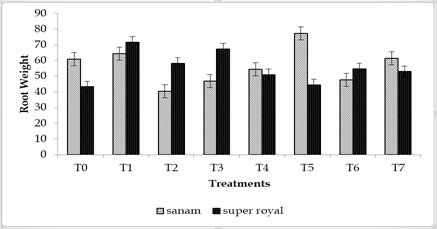 Figure 12: Root weight of two varieties (sanam and super royal) in different treatments (T0: Recommended Dose: 100-80-60 (NPK kg/ha), T1: 100-80-0 (NP kg/ha), T2: Humic acid @ 35kg/ha, T3: FYM @ 20 tons/ha, T4: Poultry manure @ 5tons/ha, T5: 50-40-30 (NPK) + Humic acid @17.5kg/ha, T6: 50-40-30 (NPK) +FYM @10tons/ha, T7: 25-20-15 (NPK) + Humic acid @17.5kg/ha +FYM @ 10 tons/ha +Poultry manure @ 2.5tons/ha).
Figure 12: Root weight of two varieties (sanam and super royal) in different treatments (T0: Recommended Dose: 100-80-60 (NPK kg/ha), T1: 100-80-0 (NP kg/ha), T2: Humic acid @ 35kg/ha, T3: FYM @ 20 tons/ha, T4: Poultry manure @ 5tons/ha, T5: 50-40-30 (NPK) + Humic acid @17.5kg/ha, T6: 50-40-30 (NPK) +FYM @10tons/ha, T7: 25-20-15 (NPK) + Humic acid @17.5kg/ha +FYM @ 10 tons/ha +Poultry manure @ 2.5tons/ha).
Whole plant weight (g)
Maximum plant weight (433.6 g) was noted in T0 at sanam followed by (379.9 g) in T1 at super royal. Minimum average plant weight (166.2 g) was noted in T6 at sanam. Sanam showed better performance than super royal (Table 3, Figure 13). For whole plant weight T0 showed significant dissimilarity from all the treatments in variety sanam. In variety super royal T0 showed significant change from T1, T5 and T6 while non-significant difference from T2, T3, T4 and T7 (Figure 13).
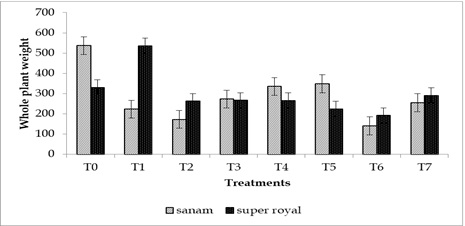 Figure 13: Whole plant weight of two varieties (sanam and super royal) in different treatments (T0: Recommended Dose: 100-80-60 (NPK kg/ha), T1: 100-80-0 (NP kg/ha), T2: Humic acid @ 35kg/ha, T3: FYM @ 20 tons/ha, T4: Poultry manure @ 5tons/ha, T5: 50-40-30 (NPK) + Humic acid @17.5kg/ha, T6: 50-40-30 (NPK) +FYM @10tons/ha, T7: 25-20-15 (NPK) + Humic acid @17.5kg/ha +FYM @ 10 tons/ha +Poultry manure @ 2.5tons/ha).
Figure 13: Whole plant weight of two varieties (sanam and super royal) in different treatments (T0: Recommended Dose: 100-80-60 (NPK kg/ha), T1: 100-80-0 (NP kg/ha), T2: Humic acid @ 35kg/ha, T3: FYM @ 20 tons/ha, T4: Poultry manure @ 5tons/ha, T5: 50-40-30 (NPK) + Humic acid @17.5kg/ha, T6: 50-40-30 (NPK) +FYM @10tons/ha, T7: 25-20-15 (NPK) + Humic acid @17.5kg/ha +FYM @ 10 tons/ha +Poultry manure @ 2.5tons/ha).
Length of leaves (cm)
Maximum length of leaves (6.6 cm) was noted in T0 at super royal followed by (6.5 cm) T2 at super royal. Minimum length of leaves (5.7 cm) was noted in T7 at super royal. Overall sanam showed better performance than super royal (Table 3, Figure 14). In variety sanam, T0 showed significant difference from T3 while non-significant difference from all other treatments. In variety super royal, T0 showed significant difference fom T5 while non-significant difference from T1, T2, T3, T4, T6 and T7 (Figure 14).
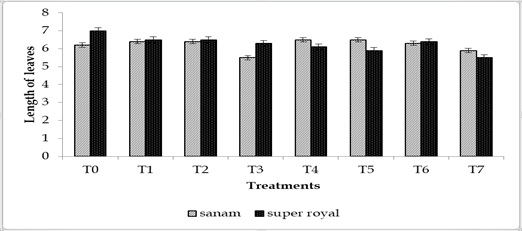 Figure 14: Leaves length of two varieties (sanam and super royal) in different treatments (T0: Recommended Dose: 100-80-60 (NPK kg/ha), T1: 100-80-0 (NP kg/ha), T2: Humic acid @ 35kg/ha, T3: FYM @ 20 tons/ha, T4: Poultry manure @ 5tons/ha, T5: 50-40-30 (NPK) + Humic acid @17.5kg/ha, T6: 50-40-30 (NPK) +FYM @10tons/ha, T7: 25-20-15 (NPK) + Humic acid @17.5kg/ha +FYM @ 10 tons/ha +Poultry manure @ 2.5tons/ha).
Figure 14: Leaves length of two varieties (sanam and super royal) in different treatments (T0: Recommended Dose: 100-80-60 (NPK kg/ha), T1: 100-80-0 (NP kg/ha), T2: Humic acid @ 35kg/ha, T3: FYM @ 20 tons/ha, T4: Poultry manure @ 5tons/ha, T5: 50-40-30 (NPK) + Humic acid @17.5kg/ha, T6: 50-40-30 (NPK) +FYM @10tons/ha, T7: 25-20-15 (NPK) + Humic acid @17.5kg/ha +FYM @ 10 tons/ha +Poultry manure @ 2.5tons/ha).
Width of leaves (cm)
Maximum width of leaves (3.9 cm) was noted in T0 at super royal followed by T6 (3.8 cm) at sanam and T0 (3.8 cm) at sanam. Minimum width of leaves (3.5 cm) was noted in T3 at sanam (Table 3, Figure 15). For width of leaves, T0 showed significant difference from T3 and non-significant difference from all T1, T2, T4, T5, T6 and T7 in variety sanam. In variety super royal T0 showed significant difference from T7 while non-significant difference from T1, T2, T3, T4, T5 and T6 (Figure 15). 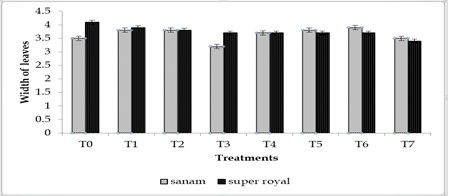
Figure 15: Leaves width of two varieties (sanam and super royal) in different treatments (T0: Recommended Dose: 100-80-60 (NPK kg/ha), T1: 100-80-0 (NP kg/ha), T2: Humic acid @ 35kg/ha, T3: FYM @ 20 tons/ha, T4: Poultry manure @ 5tons/ha, T5: 50-40-30 (NPK) + Humic acid @17.5kg/ha, T6: 50-40-30 (NPK) +FYM @10tons/ha, T7: 25-20-15 (NPK) + Humic acid @17.5kg/ha +FYM @ 10 tons/ha +Poultry manure @ 2.5tons/ha).
Fruit length (mm)
Maximum fruit length (62.7 mm) was noted in T4 at super royal followed by (61.5 mm) in T5 at super royal and (60 mm) in T7 at super royal. Minimum fruit length (51.3 mm) was noted in T3 at sanam. Overall super royal showed better performance than sanam (Table 3, Figure 16). In variety sanam T0 showed significant difference from T4, T5 and T7 while non-significant difference from T1, T2, T3 and T6. T0 showed significant difference from T3 and T6 while non-significant difference from T1, T2, T4, T5 and T7 in variety super royal (Figure 16).
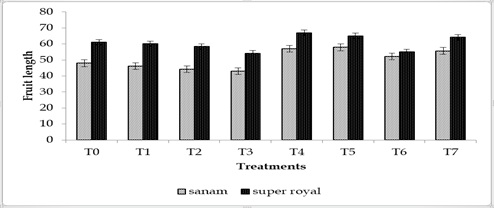 Figure 16: Fruit length of two varieties (sanam and super royal) in different treatments (T0: Recommended Dose: 100-80-60 (NPK kg/ha), T1: 100-80-0 (NP kg/ha), T2: Humic acid @ 35kg/ha, T3: FYM @ 20 tons/ha, T4: Poultry manure @ 5tons/ha, T5: 50-40-30 (NPK) + Humic acid @17.5kg/ha, T6: 50-40-30 (NPK) +FYM @10tons/ha, T7: 25-20-15 (NPK) + Humic acid @17.5kg/ha +FYM @ 10 tons/ha +Poultry manure @ 2.5tons/ha).
Figure 16: Fruit length of two varieties (sanam and super royal) in different treatments (T0: Recommended Dose: 100-80-60 (NPK kg/ha), T1: 100-80-0 (NP kg/ha), T2: Humic acid @ 35kg/ha, T3: FYM @ 20 tons/ha, T4: Poultry manure @ 5tons/ha, T5: 50-40-30 (NPK) + Humic acid @17.5kg/ha, T6: 50-40-30 (NPK) +FYM @10tons/ha, T7: 25-20-15 (NPK) + Humic acid @17.5kg/ha +FYM @ 10 tons/ha +Poultry manure @ 2.5tons/ha).
Fruit diameter (mm)
Maximum fruit diameter (49.9 mm) was noted in T4 at super royal followed by (48.9 mm) in T7 at super royal and (48.4 mm) in T5 at super royal. Minimum fruit diameter (40 mm) was noted in T3 at super royal. Overall super royal showed better performance (Table 3, Figure 17). In variety sanam T0 showed significant difference from T4, T5 and T7 while non-significant difference from T1, T2, T3 and T6. In super royal variety T0 showed significant difference from T1, T3, T4, T5 and T7 while non-significant difference from T2 and T6 (Figure 17).
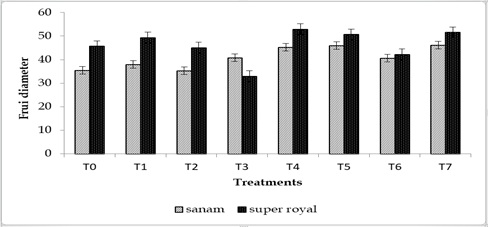 Figure 17: Fruit diameter of two varieties (sanam and super royal) in different treatments (T0: Recommended Dose: 100-80-60 (NPK kg/ha), T1: 100-80-0 (NP kg/ha), T2: Humic acid @ 35kg/ha, T3: FYM @ 20 tons/ha, T4: Poultry manure @ 5tons/ha, T5: 50-40-30 (NPK) + Humic acid @17.5kg/ha, T6: 50-40-30 (NPK) +FYM @10tons/ha, T7: 25-20-15 (NPK) + Humic acid @17.5kg/ha +FYM @ 10 tons/ha +Poultry manure @ 2.5tons/ha).
Figure 17: Fruit diameter of two varieties (sanam and super royal) in different treatments (T0: Recommended Dose: 100-80-60 (NPK kg/ha), T1: 100-80-0 (NP kg/ha), T2: Humic acid @ 35kg/ha, T3: FYM @ 20 tons/ha, T4: Poultry manure @ 5tons/ha, T5: 50-40-30 (NPK) + Humic acid @17.5kg/ha, T6: 50-40-30 (NPK) +FYM @10tons/ha, T7: 25-20-15 (NPK) + Humic acid @17.5kg/ha +FYM @ 10 tons/ha +Poultry manure @ 2.5tons/ha).
Total number of fruits/plot
Maximum total number of fruits/plot (180.2) was noted in T4 at sanam followed by (158.2) in T7 in sanam. Minimum total number of fruits/plot (85.8) was noted in T6 at super royal. Overall sanam showed better performance than super royal (Table 3, Figure 18). In sanam T0 showed significant difference from T4, T5, T6 and T7 while non-significant difference from T1, T2 and T3. In super royal, T0 showed significant difference from T2, T3 and T6 while non-significant difference from T1, T4, T5 and T7 (Figures 18 & 19).
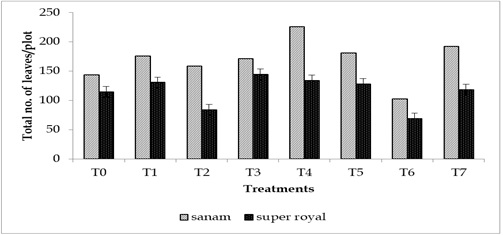 Figure 18: Total number of leaves/plot of two varieties (sanam and super royal) in different treatments (T0: Recommended Dose: 100-80-60 (NPK kg/ha), T1: 100-80-0 (NP kg/ha), T2: Humic acid @ 35kg/ha, T3: FYM @ 20 tons/ha, T4: Poultry manure @ 5tons/ha, T5: 50-40-30 (NPK) + Humic acid @17.5kg/ha, T6: 50-40-30 (NPK) +FYM @10tons/ha, T7: 25-20-15 (NPK) + Humic acid @17.5kg/ha +FYM @ 10 tons/ha +Poultry manure @ 2.5tons/ha).
Figure 18: Total number of leaves/plot of two varieties (sanam and super royal) in different treatments (T0: Recommended Dose: 100-80-60 (NPK kg/ha), T1: 100-80-0 (NP kg/ha), T2: Humic acid @ 35kg/ha, T3: FYM @ 20 tons/ha, T4: Poultry manure @ 5tons/ha, T5: 50-40-30 (NPK) + Humic acid @17.5kg/ha, T6: 50-40-30 (NPK) +FYM @10tons/ha, T7: 25-20-15 (NPK) + Humic acid @17.5kg/ha +FYM @ 10 tons/ha +Poultry manure @ 2.5tons/ha).
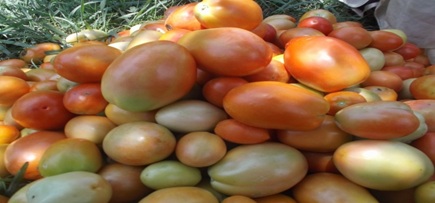 Figure 19: Tomatoes produced by T4 (poultry manure).
Figure 19: Tomatoes produced by T4 (poultry manure).
Total weight of fruit/plot (kg)
Maximum total weight of fruits/plot (10477 kg) was noted in T4 at sanam followed by (8989 kg) in sanam at T7 and (7842 kg) in T5 at sanam. Minimum total weight of fruits/plot (4503 kg) was noted in T6 at super royal. Overall sanam showed better performance than super royal (Table 3). In variety sanam, T0 showed significant difference from T1, T3, T4, T5, T6 and T7 while no-significant change from T2. In variety super royal T0 showed significant difference from T1, T2, T4, T6 and T7 while non-significant dissimilarity from T3 and T5 (Figure 20). 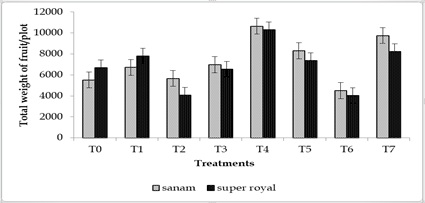
Figure 20: Total weight of fruit/plot of two varieties (sanam and super royal) in different treatments (T0: Recommended Dose: 100-80-60 (NPK kg/ha), T1: 100-80-0 (NP kg/ha), T2: Humic acid @ 35kg/ha, T3: FYM @ 20 tons/ha, T4: Poultry manure @ 5tons/ha, T5: 50-40-30 (NPK) + Humic acid @17.5kg/ha, T6: 50-40-30 (NPK) +FYM @10tons/ha, T7: 25-20-15 (NPK) + Humic acid @17.5kg/ha +FYM @ 10 tons/ha +Poultry manure @ 2.5tons/ha).
Organic matter
In pre harvest organic matter was 1.6. In post-harvest, maximum organic matter (1.9) was noted in T6 at super royal followed by (1.8) in T2 at sanam. Minimum organic matter (0) was noted in T7. Overall sanam showed maximum organic matter than super royal (Table 4, Figure 21). T0 showed significant difference from T1, T2, T3, T5, T6 and T7 while non-significant difference from T4 in variety sanam. In variety super royal T0 showed significant difference from T2, T3, T4, T5, T6 and T7 while non-significant dissimilarity from T1 (Figure 21).
|
Treatments |
Organic Matter |
Electric conductivity |
pH |
Total soluble solids |
Titratible acidity |
TSS:TA |
Vitamin C |
|
Control (T0) |
0.5 D |
2.93 D |
6.5 BC |
5.2 AB |
0.52 A |
10.1 B |
21.5 C |
|
NP (T1) |
1 B |
4.45 B |
6.9 A |
3.8 BC |
0.37 E |
10.3 B |
19.4 CD |
|
Humic acid (T2) |
1.8 A |
4.31 B |
6.6 B |
3.4 C |
0.38 DE |
9 B |
15.1 D |
|
FYM (T3) |
0.6 D |
5.9 A |
6.4 C |
3.8 BC |
0.45 C |
8.6 B |
18.3 CD |
|
Poultry manure (T4) |
0 E |
3.57 C |
6.4 BC |
5.7 A |
0.41 D |
14.1 A |
34.4 A |
|
NPK + Humic acid (T5) |
0.7 C |
3.67 C |
6.5 BC |
4.0 BC |
0.46 BC |
8.6 B |
28 B |
|
NPK+FYM (T6) |
1.9 A |
3.52 C |
6.5 BC |
4.2 BC |
0.49 B |
8.7 B |
32.4 AB |
|
NPK + Humic acid +FYM +PM (T7) |
4. 0 F |
3.97 BC |
6.3 C |
5.0 AB |
0.53 A |
9.4 B
|
32.3 AB |
Table 4: Table showing mean values for organic matter, electric conductivity, pH, total soluble solids, TSS: TA and vitamin C.
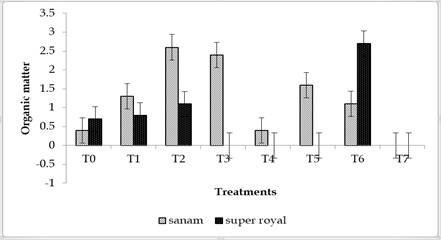 Figure 21: Soil organic matter of two varieties (sanam and super royal) in different treatments (T0: Recommended Dose: 100-80-60 (NPK kg/ha), T1: 100-80-0 (NP kg/ha), T2: Humic acid @ 35kg/ha, T3: FYM @ 20 tons/ha, T4: Poultry manure @ 5tons/ha, T5: 50-40-30 (NPK) + Humic acid @17.5kg/ha, T6: 50-40-30 (NPK) +FYM @10tons/ha, T7: 25-20-15 (NPK) + Humic acid @17.5kg/ha +FYM @ 10 tons/ha +Poultry manure @ 2.5tons/ha).
Figure 21: Soil organic matter of two varieties (sanam and super royal) in different treatments (T0: Recommended Dose: 100-80-60 (NPK kg/ha), T1: 100-80-0 (NP kg/ha), T2: Humic acid @ 35kg/ha, T3: FYM @ 20 tons/ha, T4: Poultry manure @ 5tons/ha, T5: 50-40-30 (NPK) + Humic acid @17.5kg/ha, T6: 50-40-30 (NPK) +FYM @10tons/ha, T7: 25-20-15 (NPK) + Humic acid @17.5kg/ha +FYM @ 10 tons/ha +Poultry manure @ 2.5tons/ha).
Electric conductivity
In pre harvest EC was 5.55. In post-harvest, maximum electric conductivity (5.9) was noted in T3 in sanam followed by (4.45) in T1 at sanam and (4.31) in T2 in sanam. Minimum electric conductivity (2.93) was noted in T0 at super royal. Overall Sanam showed maximum organic matter in all treatments than super royal (Table 4, Figure 22). T0 showed significant difference from T1, T2, T3, T4, T5 and T7 while non-significant dissimilarity from T6 in variety sanam. In super royal, T0 showed significant difference from T1, T2, T3 and T7 while non-significant difference from T4, T5 and T6 (Figure 22).
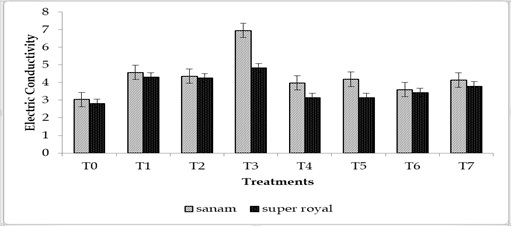 Figure 22: Soil electric conductivity of two varieties (sanam and super royal) in different treatments (T0: Recommended Dose: 100-80-60 (NPK kg/ha), T1: 100-80-0 (NP kg/ha), T2: Humic acid @ 35kg/ha, T3: FYM @ 20 tons/ha, T4: Poultry manure @ 5tons/ha, T5: 50-40-30 (NPK) + Humic acid @17.5kg/ha, T6: 50-40-30 (NPK) +FYM @10tons/ha, T7: 25-20-15 (NPK) + Humic acid @17.5kg/ha +FYM @ 10 tons/ha +Poultry manure @ 2.5tons/ha).
Figure 22: Soil electric conductivity of two varieties (sanam and super royal) in different treatments (T0: Recommended Dose: 100-80-60 (NPK kg/ha), T1: 100-80-0 (NP kg/ha), T2: Humic acid @ 35kg/ha, T3: FYM @ 20 tons/ha, T4: Poultry manure @ 5tons/ha, T5: 50-40-30 (NPK) + Humic acid @17.5kg/ha, T6: 50-40-30 (NPK) +FYM @10tons/ha, T7: 25-20-15 (NPK) + Humic acid @17.5kg/ha +FYM @ 10 tons/ha +Poultry manure @ 2.5tons/ha).
pH
In pre harvest pH was 7. In post-harvest, maximum pH (6.9) was noted in T1 at super royal followed by T2 (6.6) and T0 (6.5). Minimum pH (6.3) was noted in T7 at sanam. Overall Super royal showed maximum pH (Table 4, Figure23). T0 showed significant difference from T1, T3 and T7 while non-significant difference from T2, T4, T5 and T6 in variety sanam. In variety super royal, T0 showed significant difference from T1 while non-significant difference from all other treatments (Figure 23). There were 3 groups (A, B, etc.) in which the means were not significantly dissimilar from one another. All 2 means of varieties were significantly different from one another (appendix 42).
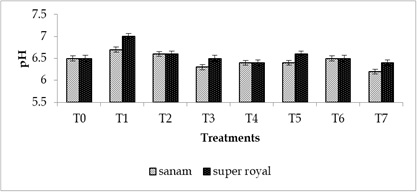 Figure 23: Soil pH of two varieties (sanam and super royal) in different treatments (T0: Recommended Dose: 100-80-60 (NPK kg/ha), T1: 100-80-0 (NP kg/ha), T2: Humic acid @ 35kg/ha, T3: FYM @ 20 tons/ha, T4: Poultry manure @ 5tons/ha, T5: 50-40-30 (NPK) + Humic acid @17.5kg/ha, T6: 50-40-30 (NPK) +FYM @10tons/ha, T7: 25-20-15 (NPK) + Humic acid @17.5kg/ha +FYM @ 10 tons/ha +Poultry manure @ 2.5tons/ha).
Figure 23: Soil pH of two varieties (sanam and super royal) in different treatments (T0: Recommended Dose: 100-80-60 (NPK kg/ha), T1: 100-80-0 (NP kg/ha), T2: Humic acid @ 35kg/ha, T3: FYM @ 20 tons/ha, T4: Poultry manure @ 5tons/ha, T5: 50-40-30 (NPK) + Humic acid @17.5kg/ha, T6: 50-40-30 (NPK) +FYM @10tons/ha, T7: 25-20-15 (NPK) + Humic acid @17.5kg/ha +FYM @ 10 tons/ha +Poultry manure @ 2.5tons/ha).
Total Soluble Solids (TSS)
Maximum TSS (5.7) was noted in T4 followed by T0 (5.2) and T7 (5). Minimum TSS (3.4) was noted in T2 (Table 4, Figure 24). For total soluble solids, T0 showed significant difference from T1, T2, T3, T4, T5 and T6 while non-significant difference from T7 in sanam. In super royal, T0 showed significant difference from T1, T2, T3, T4, T5 and T6 while non-significant difference from T7 (Figure 24).
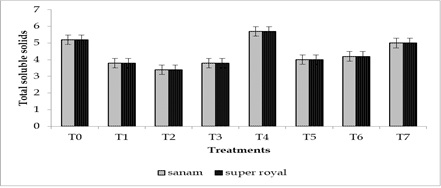
Figure 24: Total Soluble Solids of two varieties (sanam and super royal) in different treatments (T0: Recommended Dose: 100-80-60 (NPK kg/ha), T1: 100-80-0 (NP kg/ha), T2: Humic acid @ 35kg/ha, T3: FYM @ 20 tons/ha, T4: Poultry manure @ 5tons/ha, T5: 50-40-30 (NPK) + Humic acid @17.5kg/ha, T6: 50-40-30 (NPK) +FYM @10tons/ha, T7: 25-20-15 (NPK) + Humic acid @17.5kg/ha +FYM @ 10 tons/ha +Poultry manure @ 2.5tons/ha).
Titratable Acidity (TA)
Maximum TA (0.53) was noted in T7 followed by T0 (0.52) and T6 (0.49). Minimum TA (0.37) was noted in T1 (Table 4, Figure 25). T0 showed significance difference from T6, T5, T4, T3, T2 and T1 while non-significant difference in both the varieties sanam and super royal (Figure 25).

Figure 25: Titratable acidity of two varieties (sanam and super royal) in different treatments (T0: Recommended Dose: 100-80-60 (NPK kg/ha), T1: 100-80-0 (NP kg/ha), T2: Humic acid @ 35kg/ha, T3: FYM @ 20 tons/ha, T4: Poultry manure @ 5tons/ha, T5: 50-40-30 (NPK) + Humic acid @17.5kg/ha, T6: 50-40-30 (NPK) +FYM @10tons/ha, T7: 25-20-15 (NPK) + Humic acid @17.5kg/ha +FYM @ 10 tons/ha +Poultry manure @ 2.5tons/ha).
Ratio of Titratable Acidity and Total Soluble Solids (TSS: TA)
Maximum TSS: TA (14.1) was noted in T4 followed by T1 (10.3) and T0 (10.1). Minimum TSS: TA (8.6) was noted in T3 and T5 (Table 4, Figure 26). In both varieties, T0 showed significant difference from T4 while non-significant difference from all other treatments (Figure 26).
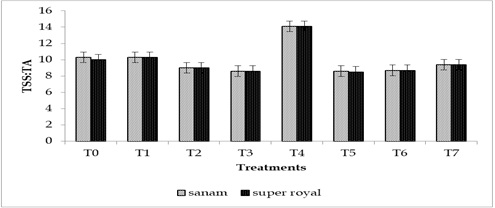 Figure 26: TSS: TA of two varieties (sanam and super royal) in different treatments (T0: Recommended Dose: 100-80-60 (NPK kg/ha), T1: 100-80-0 (NP kg/ha), T2: Humic acid @ 35kg/ha, T3: FYM @ 20 tons/ha, T4: Poultry manure @ 5tons/ha, T5: 50-40-30 (NPK) + Humic acid @17.5kg/ha, T6: 50-40-30 (NPK) +FYM @10tons/ha, T7: 25-20-15 (NPK) + Humic acid @17.5kg/ha +FYM @ 10 tons/ha +Poultry manure @ 2.5tons/ha).
Figure 26: TSS: TA of two varieties (sanam and super royal) in different treatments (T0: Recommended Dose: 100-80-60 (NPK kg/ha), T1: 100-80-0 (NP kg/ha), T2: Humic acid @ 35kg/ha, T3: FYM @ 20 tons/ha, T4: Poultry manure @ 5tons/ha, T5: 50-40-30 (NPK) + Humic acid @17.5kg/ha, T6: 50-40-30 (NPK) +FYM @10tons/ha, T7: 25-20-15 (NPK) + Humic acid @17.5kg/ha +FYM @ 10 tons/ha +Poultry manure @ 2.5tons/ha).
Vitamin C
Maximum Vitamin C (34.4 mg/100mL) was noted in T4 followed by T6 (32.4 mg/100mL) and T7 (32.3 mg/100mL). Minimum Vitamin C (15.1 mg/100mL) was noted in T2. (Table 4, Figure 27). In both the varieties T0 showed significant difference from T1, T2, T3, T4, T5 and non-significant difference from T6 and T7 (Figure 27).
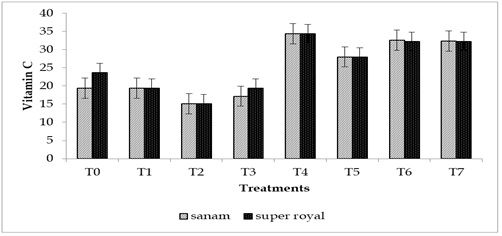 Figure 27: Vitamin C of two varieties (sanam and super royal) in different treatments (T0: Recommended Dose: 100-80-60 (NPK kg/ha), T1: 100-80-0 (NP kg/ha), T2: Humic acid @ 35kg/ha, T3: FYM @ 20 tons/ha, T4: Poultry manure @ 5tons/ha, T5: 50-40-30 (NPK) + Humic acid @17.5kg/ha, T6: 50-40-30 (NPK) +FYM @10tons/ha, T7: 25-20-15 (NPK) + Humic acid @17.5kg/ha +FYM @ 10 tons/ha +Poultry manure @ 2.5tons/ha).
Figure 27: Vitamin C of two varieties (sanam and super royal) in different treatments (T0: Recommended Dose: 100-80-60 (NPK kg/ha), T1: 100-80-0 (NP kg/ha), T2: Humic acid @ 35kg/ha, T3: FYM @ 20 tons/ha, T4: Poultry manure @ 5tons/ha, T5: 50-40-30 (NPK) + Humic acid @17.5kg/ha, T6: 50-40-30 (NPK) +FYM @10tons/ha, T7: 25-20-15 (NPK) + Humic acid @17.5kg/ha +FYM @ 10 tons/ha +Poultry manure @ 2.5tons/ha).
Discussion
Statistical analysis of data of present experiment revealed that fertilizer applications have significant effect with the parameter of number of leaves/plant. T1, T3, T4, T6 differ from control but no significant difference was found between control and T2, T5. Maximum number of leaves/plant (375.6) was recorded in in super royal at T1 followed by (375.5) in T4 at sanam and (325.9) in T7 at sanam. These results differ from [69], who assumed that number of leaves has linear significant difference with the inorganic fertilizer treatments. Their results showed decreased number of leaves with the increase of inorganic fertilizers. Sanam (V1) was proved better variety over super royal; it produced maximum average number of leaves/plant (337.3). These results are at per [70], who stated that there exists significant difference between two varieties and Shah Alam gave maximum number of leaves. Statistical analysis of data of present experiment revealed that fertilizer applications have significant effect on the height of plant. Statistical analysis reveals that in variety super royal T0 (control) is significantly dissimilar from T2, T3, T5, T6 and T7 while T4 and T1 are non-significantly changed from T0. In variety sanam T0 was significantly different from T1, T4 and T6 while all the other treatments are non-significantly different from the control treatment. Maximum plant height (81.2 cm) was noted in T0 at super royal followed by T4 (80.8 cm) at sanam and T5 (73.7 cm) at sanam. These outcomes are in conformity with the outcomes of [71], who described that linear increase in plant height with the increase in plant height with the increase of fertilizer recommended dose. Sanam (V1) was proved better variety over super royal; it produced maximum average plant height (75.1 cm) while there were no significant pairwise differences among the means of varieties. These findings deviate from the findings of [72] who found significant dissimilarity amongst varieties and noted best results with Pulkara. These findings also differ from the results of [70], who reported significant dissimilarity between different varieties. These deviations are probably due to the difference of varieties used or difference in the climatic conditions.
Statistical analysis of data of present experiment revealed that fertilizer applications have significant effect on the primary branches. T0 shows significant difference from all the treatments. Maximum primary branches (2.9) were found in super royal at T0 (control) followed by (2.8) in T7 in super royal and (2.5) at T6 in super royal. Maximum average primary branches (2) were perceived by sanam. These findings are in conformity with the results of [73] who stated that NPK shows best results regarding the branches.
Statistical analysis of data of present experiment revealed that fertilizer applications have significant effect on the secondary branches. Significant difference exists between control and all the treatments. Maximum secondary branches (11.8) were noted in T0 followed by T7 (10.9) and T6 (10.4). Both the varieties show no significant difference in average secondary branches and there were no significant pairwise differences among the means of varieties. These results are in conformity with the results of [73] who stated that by increasing NPK number of secondary branches also increases, they have direct relation but there was no significant difference between the different varieties. So it is proved that the parameter secondary branches have no significant effect among varieties.
Statistical analysis of data of present experiment revealed that fertilizer applications have significant effect on the stem girth. T0 is significantly different from all other treatments in variety super royal. In variety sanam T0 is significantly different from T4 while all other treatments are non-significantly different from the control treatment. Maximum stem girth (11.3 mm) was noted in T4 at sanam followed by (10.1 mm) in T7 at sanam and (10.1 mm) in T3 at sanam. Sanam (V1) was proved better variety over super royal; it produced maximum average stem girth (10.4 mm) while all two means were significantly different from one another. These outcomes are similar to the results of [74] who reported that organic fertilizers plays an important role in the growth of the plant, by proper using organic fertilizers we can increase the stem girth.
For fresh weight of leaves, in variety super royal, T0 was significantly dissimilar from T1, T3, T4 and T7 while non-significantly different from T2, T5 and T6. In variety sanam, T0 was significantly dissimilar from T1, T6 and T7 while non-significantly dissimilar from all other treatments. Maximum fresh weight of leaves (41.5 g) was noted in T1 at super royal followed by (35 g) in T6 at sanam and (33.3 g) in super royal at T5. These results are similar with the results of [19] who reported that using fertilizers has a significant impact the leaves, by using fertilizers with proper care and management leaves would be healthy. Minimum average fresh weight of leaves (31.1) was perceived in Sanam (V1). While there were no significant pairwise differences among the means. Results are different from the results of [19]. Results differ may be due to difference in the climatic conditions and the difference in the selection of varieties.
For dry weight of leaves, in variety super royal, T0 was significantly dissimilar from T1, T3, T4 and T6 while non-significantly dissimilar to T2, T5 and T7. In variety sanam, T0 was non-significantly different from T2 while significantly dissimilar from all other treatments. Maximum average dry weight of leaves (9.4 g) was perceived in Sanam (V1). All 2 means were significantly dissimilar from one another. T1, T2, T3, T5, T6 and T7 showed significance change with control treatment. Maximum dry weight of leaves (10.3 g) was noted in sanam at T6 followed by (10 g) at T5 in sanam. The findings are in conformity with the results of [74] who stated that the parameter dry weight of leaves has direct relation with the use of fertilizers.
Maximum root length (23.1 cm) was perceived in Sanam (V1). Results revealed that T0 was significantly dissimilar from T1, T4 and T7 while non-significantly different from T2, T3, T5 and T6 in variety sanam. In super royal, T0 was non–significantly dissimilar from T5 while significant dissimilar from T1, T2, T3, T4, T6 and T7. Maximum root length (24.2 cm) was noted in T7 at sanam followed by (23.1 cm) in sanam at T4 and (23 cm) in sanam at T1. Results are in conformity with the results of [45]. He stated that fertilizers improve the structure of root. The addition of fertilizers has a significant effect on the roots of different varieties. Sanam (V1) showed better performance, as it perceived maximum average root weight (56.8).
Results revealed that in variety super royal, T0 showed significant difference from T1, T2, T3, T4, T6 and T7 while non-significant difference from T5. In variety sanam, T0 shows significant difference from T2, T3, T5 and T6 while non-significant difference from T1, T4 and T7.
Maximum root weight (68.2 g) was noted in T5 at sanam followed by (61 g) in sanam at T1. These findings are in conformity with the [45], who reported that fertilizers improve the structure of root. The addition of fertilizers has a significant effect on the roots of different varieties, using fertilizer have direct relation with the parameter root weight.
Maximum length of leaves (6.3 cm) was perceived in Sanam (V1). There were no significant pairwise differences among the means. T1, T3, T4, T5, T6 and T7 revealed significance difference with control treatment. Maximum length of leaves (6.6 cm) was noted in T0 at super royal followed by (6.5 cm) T2 at super royal. Results are similar to the results of [74] who stated the similar results he concluded that the NPK is the best treatment for the parameter length of leaves but it has no effect no different varieties.
Fertilizers showed no valuable effect on the width of leaves. Statistical analysis of data revealed no significant difference between T1, T2, T5, T6 and control treatment. T3, T4, T7 showed significant difference with control treatment. Maximum width of leaves (3.9 cm) was noted in T1 followed by T6 (3.8 cm) and T0 (3.8 cm). There was no significant difference of width of leaves between the varieties. There were no significant pairwise differences among the means. Our findings showed no significant of this parameter, results differ from the results of [74] who reported that the width of leaves has a significant effect on the width of leaves between different varieties. This difference is due to the difference in the fertilizers used and the difference in environmental conditions.
Maximum average fruit length (60.3 mm) was perceived in V2 (Super Royal). All 2 means were significantly different from one another. Significant difference was found between all treatments and control treatment. Maximum fruit length (62.7 mm) was noted in T4 at super royal followed by (61.5 mm) in T5 at super royal and (60 mm) in T7 at super royal. The findings are in conformity with the results of [73] who reported the same results. He stated that use of fertilizer has a great impact on the fruit length; it can increase the length of fruit.
Maximum average fruit diameter (46.7 mm) was perceived in Super Royal (V2). All 2 means of varieties were significantly different from one another. Significant difference was found between control (T0) and T1, T4, T5, T6, T7. Maximum fruit diameter (49.9 mm) was noted in T4 at super royal followed by (48.9 mm) in T7 at super royal and (48.4 mm) in T5 at super royal. The results are in conformity with the results of [73].
Data analyzing regarding total number of fruits reveals that there is a significant difference among two varieties. Maximum total number of fruits/plot (169.1) was perceived in Sanam (V1). All 2 means were significantly different from one another. Significant difference was found between control and all treatments. Maximum total number of fruits/plot (180.2) was noted in T4 at sanam followed by (158.2) in T7 in sanam. Results are in conformity with the results of [74] who reported that poultry litter has high concentration of nutrients , so by adding adequate amount of poultry litter with proper care can meet the requirements of crop nutrients, as it is inexpensive source of both macro and micro nutrients, it enhance the soil microbiology and fruit quantity.
Maximum total weight of fruits/plot (7261.2 kg) was perceived in Sanam (V1). Significant difference was noted between control and all treatments. Maximum total weight of fruits/plot (10477 kg) was noted in T4 at sanam followed by (8989 kg) in sanam at T7 and (7842 kg) in T5 at sanam. Results are similar with the results [74].
Maximum organic matter (1.1) was perceived in Sanam (V1). All 2 means were significantly dissimilar from one another. T1, T2, T4, T5, T6 and T7 revealed significant dissimilarity with control treatment. Maximum organic matter (1.9) was noted in T6 at super royal followed by (1.8) in T2 at sanam. Results are similar with the [57], who reported that in Pakistan, PYM is the most important organic manure as it is cheap and easy available, it is estimated that about 1.5 million tons of nutrients are obtainable from the poultry manure. PYM increases the quality and quantity of tomato.
Maximum electric conductivity (4.36) was perceived in Sanam (V1). All 2 means were significantly different from one another.All treatments revealed significant difference with control. Maximum electric conductivity (5.9) was noted in T3 in sanam followed by (4.45) in T1 at sanam and (4.31) in T2 in sanam. It is important to know that EC above 4 is not good for the crop; it means that T3 has a negative effect on the crop as it has 5.9 EC. The results are in conformity with the [45], who reported that electric conductivity has a significant effect on the tomato varieties.
TSS showed no significant difference on varieties. Significant difference was found between control (T0) and T1, T2, T3, T4, T5, T6. Maximum TSS (5.7) was noted in T4 followed by T0 (5.2) and T7 (5). Our results related to TSS are in conformity with the findings of Princi et al., (2011).
TA showed no significant difference on varieties while effect on TA by treatments was found significant. Maximum TA (0.53) was noted in T7 followed by T0 (0.52) and T6 (0.49). Our results are supported by the findings [76].
Significant difference was found in the Vitamin C regarding all treatments. Maximum Vitamin C (34.4) was noted in T4 followed by T6 (32.4) and T7 (32.3). Vitamin C was revealed maximum in the T4 treatment, other treatments reduces the amount of vitamin C.
Maximum average Vitamin C was noted (25.5) in Super Royal (V2). Our results are supported by the results of [77-92].
Conclusion
Tomato variety Sanam performed far better as compared to variety Super Royal in agro climatic conditions of Mansehra. Tomato variety Sanam revealed better average plant height (75.1 cm) as compared to Super Royal (72.6 cm). Tomato variety Sanam revealed better average primary branches (2) as compared to Super Royal (1.9). Tomato variety Sanam revealed maximum average stem girth (10.4 mm) as compared to Super Royal (9.7 mm). Tomato variety Sanam revealed maximum average number of leaves (337.3) as compared to Super Royal (275.2). Tomato variety Sanam revealed maximum average fresh weight of leaves (31.1 g) as compared to Super Royal (28.9 g). Tomato variety Sanam revealed maximum average dry weight of leaves (9.4) as compared to Super Royal (7.7 g). Tomato variety Sanam revealed better average root length (23.1 cm) as compared to Super Royal (20.6 cm). Tomato variety Sanam revealed better average root weight (56.8 g) as compared to Super Royal (55.5 g). Tomato variety Sanam revealed better average whole plant weight (296.1 cm) as compared to Super Royal (285.6 cm). Tomato variety Sanam revealed better average length of leaves (6.3 cm) as compared to Super Royal (6.2 cm). Tomato variety Sanam revealed better average of total number of fruits /plot (169.1) as compared to Super Royal (115.5). Tomato variety Sanam revealed better average weight of total number of fruits /plot (7261.2 kg) as compared to Super Royal (6939.3 kg). Tomato variety Sanam revealed maximum average of organic matter (1.1) as compared to Super Royal (0.1). Tomato variety Sanam revealed maximum average of Electric conductivity (4.36) as compared to Super Royal (3.72). Tomato variety Sanam revealed better average of TSS: TA (9.9) as compared to Super Royal (9.8). Secondary branches showed no difference between both the varieties Sanam and Super Royal. Width of leaves showed no difference between both the varieties Sanam and Super Royal. Total soluble solids showed no difference between both the varieties Sanam and Super Royal. Titratible acidity showed no difference between both the varieties Sanam and Super Royal.
In case of different fertilizer treatments, T4 was proved to be the better fertilizer as compared to the other fertilizers. Maximum fruit length (62.7 mm) and fruit diameter (49.9 mm) was shown under T4. Maximum total number of fruits/plot (180.2) was shown under the treatment T4. Maximum weight of total number of fruits/plot (10477 kg) was shown under the treatment T4. Maximum total soluble solids (5.7) were shown under the treatment T4. Maximum ratio of TSS and TA (14.1) was shown under the treatment T4. Maximum vitamin c (34.4) was shown under the treatment T4.
Recommendations
According to the environmental conditions of Mansehra, sanam is better and suitable variety and it is strongly recommended to be preferred over Super Royal. Fertilizer treatment T4 (poultry manure) showed better yield and total soluble solids in the fruit, so use of T4 is recommended to achieve the maximum yield. Fertilizer treatment T6 reduces the yield, so it is not recommended for use. It is strongly recommended to investigate the effects of T4 on other crops also.
Authorship contribution statement
Jazbia Shirin: Conceptualization, Data curation, Formal analysis, Writing - original draft, Writing - review & editing. Bisharat Hussain Shah: Conceptualization, Data curation, Formal analysis.
Azhar Hussain Shah, Nazish Jabeen Abbasi, Qingye Sun, Zhou guowei: Supervision, Writing - review & editing.
Acknowledgments
This study was supported by the National Tea and High Value Crops Research Institute
Declarations of interest
The authors declare there are no competing interests.
References
- Najma YC, Aisha SK (2000) Effect of growth harmones i.e. GA, IAA and Kintin on length and diameter of shoot in Cicer arietinum 3L. Pakistan Journal of Biological Sciences 3: 1263-1266.
- Singh MA, Abu-Baker SM (1986) Physical properties of tomato fruits of nine tomato hybrids and three cultivars under plastic house conditions in the Jordan Valley. Dirasat.
- Georgiev KH, Vladimirov B, Baralieva D (1988) Venera-a new tomato variety for canning. Rasteniev dni Nauki 25: 77-80.
- Chaudhry MF, Khokhar KM, Hussain SI, Mahmood T (1999) Comparative performance of some local and exotic tomato cultivars during spring and autumn seasons. Pakistan Journal of Arid Agriculture.
- Khan TN, Jeelani G, Tariq S, Mahmood T, Hussain SI (2011) Effect of different concentrations of rooting hormones on growth of tomato cuttings (solanum esculentus l.). Journal of Agriculture Research 49: 241-247.
- Shanmugam KR, Venkataramani A (2006) Technical efficiency in agricultural production and its determinants: An exploratory study at the district level. Madras School of Economics.
- Snyman HG, Jong JM, Aveling TAS (1998) The stabilization of sewage sludge applied to agricultural land and the effects on maize seedlings. Water Science and Technology 38: 87-95.
- Nyangani ET (2010) Effect of combined application of organic manure and chemical fertilizers on soil properties and crop yields. Nigerian Journal of Science and Technology and Environmental Education. 3: 28-30.
- Tolessa D, Friesen DK (2004) Effect of enriching FYM with mineral fertilizer on grain yield of maize at Bako, western Ethopia. Integrated Approaches to Higher Maize Productivity in the New Millennium: Proceedings of the Seventh Eastern and Southern Africa Regional Maize Conference, Nairobi, Kenya, 335-337.
- FAO (2010) Commision on genetic resources for food.
- Migdadi H, Fayad M, Ajloni M, Syouf M (2007) The second report on the state of the world’s plant genetic resources for food and agriculture. Food and Agriculture Organization of the United Nations.
- Gallai N, Salles JM, Settele J, Vaissière BE (2009) Economic valuation of the vulnerability of world agriculture confronted with pollinator decline. Ecological Economics 68: 810-821.
- Idah PA, Ajigiri ESA, Yisa MG (2007) Fruits and vegetables handling and transportation in Nigeria. Australian Journal of Technology 10: 176-183.
- Iqbal S, Mastorakis N (2002) Effect of Humic Acid and Calcium Carbide on Growth and Yield of Tomato.
- Afroz A, Chaudhary Z, Khan R, Rashid H, Khan SA (2009) Effect of GA3 on regeneration response of three tomato cultivars Lycopersicon esculentum. Pakistan Journal of Botany 41: 143-151.
- Saleem MY, Asghar M, Haq MA, Rafique T, Kamran A, et al. (2009) Genetic analysis to identify suitable parents for hybrid seed production in tomato (Lycopersicon esculentum Mill.). Pakistan Journal of Botany 41: 1107-1116.
- Fozia N, Jilani MS, Kashif W, Mehwish K (2010) Performance of tomato hybrids under hydroponic culture. Pakistan Journal of Agriculture Sciences 47: 19-25.
- Sarfraz M (2008) Effect of foliar application of different nutrient formation on performance of tomato crop. M.Sc (Hons.) Thesis. PMAS Arid Agriculture University Rawalpinidi 1-4.
- Lohano H, Mari F (2005) Spatial price linkages in Regional Onion markets of Pakistan. Journal of Agriculture and Social Sciences 1: 318-321.
- Antonio I, Nigro F, Schenna S (2004) Control of Post-Harvest Diseases of Fresh Vegetable by Application of Antagonistic Micro-Organism. Crop Management and Postharvest Handling of Horticultural Products 1-30.
- Afzal IF, Munir CM, Ayub SMA, Basra A, Hameed, et al. (2013) Ethanol priming: An effective approach to enhance germination and seedling development by improving antioxidant system in tomato seeds. Acta Sci Pol Hortorum Cultus 12: 129-137.
- Ismail F (2013) Determination of water soluble vitamin in fruits and vegetables marketed in Sindh Pakistan. Pakistan Journal of Nutrition 12: 197.
- Slimestad R, Verheul MJ (2005) Content of chalconaringenin and chlorogenic acid in cherry tomatoes is strongly reduced during postharvest ripening. Journal of Agriculture and Food Chemistry 53: 7251-7256.
- Sablani SS, Opara LU, Al-Balushi K (2006) Influence of bruising and storage temperature on vitamin C content of Tomato. Journal of Food, Agriculture and Environment 4: 54-56.
- Shi J, Dai Y, Kakuda Y, Mittal G, Xue SJ (2008) Effect of heating and exposure to light on the stability of lycopene in tomato puree. Food control 19: 514-520.
- Rao AV, Waseem Z, Agarwal S (1998) Lycopene content of tomatoes and tomato products and their contribution to dietary Lycopene. Food Research International 31: 737-741.
- Beecher GR (1998) Nutrient content of tomatoes and tomato products. Proceedings of the Society for Experimental Biology and Medicine 218: 98-100.
- Farooq MS, Basra MA, Saleem BA, Nafees M, Chishti SA (2005) Enhancement of tomato seed germination and seedling vigor by osmopriming. Pakistan Journal of Agriculture Science 42: 3-4.
- Singh NP, Bharadwaj AK, Kumar A, Singh KM (2004) Modern technology on vegetable production. International book distribution Co Lucknow India 84-98.
- Oshima SF, Ojima H, Sakamoto Y, Ishiguro, Terao J (1996) Supplementation with carotenoids inhibits singlet oxygen- mediated oxidation of human plasma low density lipoprotein. Journal of Agricultural and Food Chemistry 44: 22306-22309.
- Wold AB, Rosenfeld HJ, Baugerod H, Blomhoff R (2004) The effect of fertilization on antioxident activity and chemical composition of tomato cultivars. European Journal of Horticulture Science 69: 167-174.
- Frusciante L, Barone B, Carputo D, Ercolano MR, Della Roca F, et al. (2000) Evaluation and use of plant biodiversity for food and pharmaceuticals. Fitoterapia 71: 66-72.
- Lee SK, Kader AA (2000) Preharvest and postharvest factors influencing vitamin C content of horticultural crops. Postharvest Biology and Technology 20: 207-220.
- Davies JN, Hobson GE, McGlasson WB (1981) The constituents of tomato fruit-the influence of environment, nutrition and genotype. Critical Reviews in Food Science and Nutition 15: 205-280.
- Grierson D, Kader AA (1986) Fruit ripening and quality. The Tomato Crop, A Scientific Base for Improvement. Springer Netherlands 241-280.
- Jabbar A, Mallick S (1994) Pesticides and environment situation in Pakistan. Sustainable Development Policy Institute Islamabad.
- Go P (2008) Agricultural Statistics of Pakistan 2008-2009. Economic Wing, Ministry of Food Agriculture and Livestock, Islamabad.
- Minfa M (2009) Impact of nitrogen and phosphorus on seed yield and yield components of okra cultivars. Journal of Animal and Plant Sciences 22: 704-707.
- Hillel D (1990) Role of irrigation in agricultural systems. American Society of Agronomy 30: 5-30.
- Tigchelaar EC, Foley VL (1991) Horticulture technology a case study. Horticulture Technology 1: 7-16.
- Kopriva S, Rennenberg H (2004) Control of sulphate assimilation and glutathione synthesis, interaction with N and C metabolism. Journal of Experimental Botany 55: 1831-1842.
- Sabio EM, Lozano V, Montero de Espinosa RL, Mendes AP, Pereira AF, et al. (2003) Lycopene and β-carotene extraction from tomato to processing waste using supercritical CO2. Industr and Eng Chem Res 42: 6641-6646.
- Shaheen AM, Mona M, Abdul-Mouty A, Ali H, Rizk FA (2007) Natural and chemical phosphorus fertilizers as affected onion plant growth, bulbs yield and its some physical and chemical properties. Austr J of Basic and Applied Sci 1: 519-524.
- Palm CA, Myers RJK, Nandwa SM (1997) Combined use of organic and inorganic nutrient sources for soil fertility maintenance and replenishment. Replenish soil fertil in Africa 193-217.
- Mbah C (2006) Influence of organic waste on plant growth parameters and nutrient uptake by maize (Zea may L). Nigerian J of Soil Sci 16: 104-108.
- Tonfack LB, Bernadac A, Youmbi E, Mbouapouognigni VP, Ngueguim M, et al. (2009) Impact of organic and inorganic fertilizers on tomato vigor, yield and fruit composition under tropical andosol soil conditions. Fruits 64: 167-177.
- Azad A (2000) Effects of plant spacing, source of nutrients and mulching on growth and yield of cabbage. An MS Thesis. Dept. of Hort, Bangladesh. Agril Univ Mymensingh 15-40.
- Paul G, Mannan M (2006) Integrated nutrient management in sugarcane to enhance sugar productivity. Proceedings, International Symposium on Technologies to Improve Sugar Productivity in Developing Countries. Guilin People’s Republic of China 108-121.
- Sanchez PA, Shepherd KD, Soule MJ, Place FM, Buresh RJ, et al (1997) Soil fertility replenishment in Africa: An investment in natural resource capital. Replenishing soil fertility in Africa 1-46.
- Krupnik TJ, Six J, Ladha JK, Paine MJ, Kessel CV (2004) An assessment of fertilizer nitrogen recovery efficiency by grain crops. Agri and the nitrogen cycle, assessing the impacts of fertilizer use on food prod and the env 193-207.
- Alam M (2006) Effect of vermicompost and some chemical fertilizers on yield and yield components of selective vegetable crops., Ph.D. Thesis, Faculty of Agriculture, University of Rajshahi, Bangladesh.
- Olatunji O, Oboh V (2012) Growth and yield of okra and tomato as affected by pig dung and other manures issue for economic consideration in Benue State. Nigerian J of Soil Sci 22: 103-107.
- Gagnon B, Berrouard S (1994) Effects of several organic fertilizers on growth of greenhouse tomato transplants. Canadian Journal of Plant Science 74: 167-168.
- Kelly WC (1990) Minimal use of synthetic fertilizers in vegetable production. HortScience 25: 168-169.
- Peterson AE, Walker W, Watson K (1979) Effect of whey applications on chemical properties of soils and crops. Journal of Agricultural and Food Chemistry 27: 654-658.
- Smith S, Hadley P (1989) A comparison of organic and inorganic nitrogen fertilizers: Their nitrate-N and ammonium-N release characteristics and effects on the growth response of lettuce (Lactuca sativa L. cv. Fortune). Plant and soil 15: 135-144.
- Montagu K, Goh K (1990) Effects of forms and rates of organic and inorganic nitrogen fertilisers on the yield and some quality indices of tomatoes (Lycopersicon esculentum Miller). New Zealand J of Crop and Hortic Sci 18: 31-37.
- Bari A (2003) Organic and in-organic nitrogen management for wheat and its residual on the subsequent maize crop. (Doctoral dissertation, Ph.D thesis Department of Agronomy, Agricultural.University, Peshawar, Pakistan).
- Ghosh PK, Ramesh P, Bandyopadhyay KK, Tripathi AK, Hati KM, et al. (2004) Comparative effectiveness of cattle manure, poultry manure, phosphocompost and fertilizer-NPK on three cropping systems in vertisols of semi-arid tropics. Indian institute of Soil Science Bhopal India. Bioresour Technol 95: 77-83.
- Aksoy U (2001) Ecological Farming. II. Ecological Farming Symposium in Turkey.
- Chowdhury R (2004) Effects of chemical fertilizers on the surrounding environment and the alternative to the chemical fertilizers. IES-ENVIS Newsletter 7: 4-5.
- Singh R, Sitaramaiah K (1970) Control of plant parasitic nematodes with organic soil amendments. PANS Pest Articles & News Summaries 16: 287-297.
- Hoitink H, Boehm M (1999) Biocontrol within the context of soil microbial communities: A substrate-dependent phenomenon. Annual Review of Phytopathology 37: 427-446.
- Bulluck L, Ristaino J (2002) Effect of synthetic and organic soil fertility amendments on southern blight, soil microbial communities and yield of processing tomatoes. Phytopathology 92: 181-189.
- Bulluck L, Brosius M, Evanylo GK, Ristaino J (2002) Organic and synthetic fertility amendments influence soil microbial, physical and chemical properties on organic and conventional farms. Applied Soil Ecology 19: 147-160.
- Heeb A, Lundegardh B, (2020) G.P. Savage and nutritional quality of tomatoes. Journal of Plant Nutrition and Soil Science 169: 535-541.
- Arancon NQ, Edwards CA, Bierman P, Metzger JD, Lee S, et al. (2003) Effects of vermicomposts on growth and marketable fruits of field-grown tomatoes, peppers and strawberries: The 7th international symposium on earthworm ecology 2002. Pedobiologia 47: 731-735.
- Liu B, Gumpertz ML,Hu S, Ristaino JB (2007) Long-term effects of organic and synthetic soil fertility amendments on soil microbial communities and the development of southern blight. Soil Biology and Biochemistry 39: 2302-2316.
- Farooq U, Ahmed M, Jarsa AW (2004) Natural resources conservation and poverty alleviation by making the farmers partner with empowerment. In 23rd AGM and Conference of PSDE.
- Baloch M, Baloch A, Baloch AF, Ansari G, Qayyum SM (1991) Growth and yield response of onion to different nitrogen and potassium fertilizer combination levels. Sarhad Journal of Agriculture (Pakistan).
- Ghafoor A, Ayub G, Nadeem AM, Ahmed Z, Naeem M (2003) Comparative studies on the growth, forage yield and quality of sorghum varities under irrigated conditions of Faisalabad. Pakistan Journal of Life Sciences 8: 94-97.
- Bengali K, Dutta A, Srivastava S, Paswan S (2012) Recent trends in potenial traditional indian herbs and its medical importance. Journal of Pharmacognosy and Phytochemistry 1: 1.
- Islam KM, Nawaz Q, Rizwan M, Sarfaraz M, Jamil M (2007) Response of onion to different nitrogen levels and method of transplanting in moderately in salt affected soil. Acta agriculturae Solvenica 109: 303-313.
- Gebologlu N, Yanar Y, Aydin M (2011) Effect of different organic fertilizers on yield and fruit quality of ?ndeterminate tomato (Lycopersicon esculentum). Scientific Research and Essays 6: 3623-3628.
- Ogundare SK, Hinmikaiye AS, Oladitan TO, Agbona AL (2015) Effect of neem residues and weed control methods on soil properties, weed infestation, growth and yield of eggplant (Solanum melongena L.). Journal of Radiation Research and Applied Sciences 8: 411-417.
- Maji TJ (2013) A review of biochar and soil nitrogen dynamics. Agronomy 3: 275-293.
- Serrano B, Eris A (2004) Physical and chemical changes in peaches and nectarines during the modified atmosphere storage. Food control 15: 307-313.
- Serrano M, Guillén F, Martínez-Romero D, Castillo S, Valero D (2005) Chemical constituents and antioxidant activity of sweet cherry at different ripening stages. Journal of Agricultural and Food Chemistry 53: 2741-2745.
- Anonymous (2008) National Fertilizer Development Centre (NFDC). Pakistan fertilizer related statistics, Islamabad, Pakistan.
- Anonymous (1983) Pest control in tropical tomatoes. Center for Overseas Pest Research. Overseas Development Administration. London.
- Chaudhary Z, Afroz A, Rashid H (2007) Effect of variety and plant growth regulators on callus proliferation and regeneration response of three tomato cultivars (Lycopersicon esculentum). Pakistan Journal of Botany 39: 857-869.
- Davenport LJ (2004) Genera Solanacearum: The genera of Solanaceae illustrated, arranged according to a new system by Armando T. Hunziker 221-222.
- Evans K, Lopez RM (2017) The history of the Nematology Department at Rothamsted. Annals of Appl Bio 170: 4-44.
- Franceschi S, Bidoli E, Vecchia CL, Talamini R, Avanzo BD, et al. (1994) Tomatoes and risk of digestive-tract cancers. International Journal of Cancer 59: 181-184.
- Hortwiz W (1960) Official Method of Analysis: The Association of Official Analytical Chemists (A.O.A.C). 15th Arlington, Washington D.C.
- Knapp S (2002) Tobacco to tomatoes: A phlogenetic perspective on fruit diversity in the Solanaceae. J of Experim Botany 53: 2001-2022.
- Ogwulumba SI, Ugwuoke KI, Ogbuji RO (2010) Studies on Meloidogyne javanica infestation on roma tomato (Lycopersicon esculentum Mill) under different soil amendments. African J of Biotech 9: 3280-3283.
- Prinsi B, Negri AS, Fedeli C, Morgutti S, Negrini N, et al. (2011) Peach fruit ripening: A proteomic comparative analysis of the mesocarp of two cultivars with different flesh firmness at two ripening stages. Phytochemistry 72: 1251-1262.
- Rajput MI (2004) Some studies on the control of tomato damping-of caused agent. M.Sc (Hons.) Thesis, SAUT, Tandojam.
- Ruck JA (1969) Chemical methods for analysis of fruit and vegetable products. Canadian Research Board. Summerland, Canada.
- Tilahun S, Park DS, Seo MH, Jeong CS (2017) Review on factors affecting the quality and antioxidant properties of tomatoes. African J of Biotech 16: 1678-1687.
- Udo IA (2004) Infectivity of meloidogyne incognita on elite and local cultivars of tomato in the humid tropics. Doctoral Dissertation, M.Sc Dissertation, University of Nigeria Nsukka -91.
Citation: Shirin J, Shah AH, Sun Q, Shah BH, Abbasi NJ, et al. (2023) Performance of Organic and In-Organic Fertilizers for Growth and Yield of Tomato. J Plant Sci Curr Res 7: 022.
Copyright: © 2023 Jazbia Shirin, et al. This is an open-access article distributed under the terms of the Creative Commons Attribution License, which permits unrestricted use, distribution, and reproduction in any medium, provided the original author and source are credited.
